#instantpay API Integration
Explore tagged Tumblr posts
Text
InstantPay API Integration by Infinity Webinfo Pvt Ltd

In the ever-evolving digital payment landscape, InstantPay has emerged as one of the most robust platforms for handling financial transactions. By offering a comprehensive API suite, businesses can now process payments with enhanced speed, security, and flexibility. Infinity Webinfo Pvt Ltd, a trusted name in IT solutions, takes this service to the next level with expert API Integration, ensuring a seamless experience for businesses.
Instantpay API Integration by Infinity Webinfo Pvt Ltd
What is API Integration?
API Integration involves connecting software applications through their APIs (Application Programming Interfaces). It allows different systems to communicate, share data, and function together effectively. For example, a business can integrate a payment gateway like InstantPay into their website or app, providing users with an embedded, real-time payment solution.
API Integration offers several benefits:
Automated processes: Reduces manual intervention and improves efficiency.
Real-time data sharing: Ensures smooth communication between systems.
Scalability: Facilitates increased transaction volumes without manual adjustments.
Customization: Tailored to specific business needs, providing a flexible solution.
InstantPay Overview
InstantPay is a digital financial platform that enables businesses and individuals to perform a wide range of financial services, including bill payments, money transfers, and more. It is widely known for its Business Payment Solutions and is often used as a secure way to handle transactions like salary disbursements, utility payments, and vendor payouts.
Key Features of InstantPay:
Multiple Payment Methods: InstantPay supports various payment modes including:
UPI (Unified Payments Interface): One of the most popular payment methods in India.
IMPS (Immediate Payment Service): Ensures that payments are processed instantly.
NEFT/RTGS: Bank transfer methods for larger transactions.
Debit/Credit Cards: Supporting payments through all major cards.
Instant Payouts: The InstantPay API provides the ability for businesses to transfer funds instantly to a beneficiary’s bank account, wallet, or UPI ID. This is especially useful for salary payments, refunds, and vendor payouts.
Bulk Payment Processing: Businesses often need to process multiple transactions at once. InstantPay’s bulk payment feature makes it easy to send payments to thousands of recipients in a single go.
Comprehensive Transaction Reports: The platform offers detailed insights into transactions, ensuring businesses can monitor and track payments efficiently.
Security: InstantPay is designed with multiple layers of security to protect against fraud and unauthorized transactions. Features include:
Data Encryption: Ensures all payment information is secure.
Multi-factor Authentication (MFA): Adds an extra layer of security for sensitive operations.
Tokenization: Protects card information during processing.
Compliance with Financial Regulations: InstantPay adheres to the highest compliance standards set by financial regulators like the Reserve Bank of India (RBI), ensuring all transactions meet regulatory guidelines.
Infinity Webinfo Pvt Ltd: The API Integration Experts
With an ever-growing demand for digital payments, businesses must integrate platforms like InstantPay effectively into their existing systems. This is where Infinity Webinfo Pvt Ltd excels. With years of experience in API Integration, Infinity Webinfo Pvt Ltd ensures that your business can leverage all the features of the InstantPay API smoothly.
Benefits of API Integration by Infinity Webinfo Pvt Ltd:
Custom Development: Infinity Webinfo Pvt Ltd customizes the InstantPay API integration to meet the specific needs of your business, whether it's integrating with e-commerce platforms, mobile apps, or ERP systems.
Streamlined Onboarding: Setting up InstantPay through Infinity Webinfo Pvt Ltd is quick and hassle-free. They handle everything from obtaining API keys to configuring the system, ensuring you’re ready to process payments immediately.
Technical Support & Maintenance: Post-integration, Infinity Webinfo Pvt Ltd provides ongoing technical support to ensure the system runs smoothly. Any issues are resolved quickly, and updates or patches are applied to keep the system secure and functional.
Enhanced Security: API integration through Infinity Webinfo Pvt Ltd comes with added security layers, including encryption and tokenization, ensuring that every transaction is secure.
Testing & Quality Assurance: Before the integration is rolled out, Infinity Webinfo Pvt Ltd runs rigorous tests to ensure the system works as expected. They identify any bugs or issues and ensure everything is operating at peak performance before going live.
Step-by-Step Process of InstantPay API Integration
The process of integrating InstantPay’s API with Infinity Webinfo Pvt Ltd is simple yet thorough:
Initial Consultation: Understanding your business needs—whether it’s online payments, bulk payouts, or fund transfers. Infinity Webinfo Pvt Ltd ensures that the API integration will fit seamlessly with your current processes and infrastructure.
API Documentation: Infinity Webinfo Pvt Ltd reviews InstantPay’s extensive API documentation to map out the necessary endpoints and functions required for your business.
Development: The team at Infinity Webinfo Pvt Ltd builds a customized solution based on your business requirements. This may involve setting up payment gateways, customizing workflows, or integrating with other applications like CRMs or ERPs.
Testing: Before the final implementation, Infinity Webinfo Pvt Ltd conducts rigorous testing in a secure environment to ensure the system is reliable, secure, and functions smoothly.
Security Protocol Implementation: To safeguard against any potential vulnerabilities, Infinity Webinfo Pvt Ltd implements additional encryption and security protocols. This ensures that the transaction data is protected throughout the process.
Launch: Once testing is complete, the system is deployed, and you can begin processing payments via InstantPay. Infinity Webinfo Pvt Ltd offers support during the initial stages to ensure everything works smoothly.
Ongoing Monitoring and Support: Post-launch, Infinity Webinfo Pvt Ltd continues to monitor the integration, providing any necessary updates or troubleshooting to ensure smooth operation.
Advantages of InstantPay API Integration
By integrating InstantPay with the help of Infinity Webinfo Pvt Ltd, businesses can enjoy several key advantages:
Speed & Efficiency: Instant payments and simplified processes lead to quicker transactions.
Scalability: Whether you’re processing a handful or thousands of transactions, InstantPay scales effortlessly.
Security: Robust security features ensure your transactions are safe from fraud and other security threats.
Cost-Effective: Reduces transaction fees and operational costs through automation and bulk processing.
Enhanced Customer Experience: Provide a seamless, fast, and secure payment experience for your customers.
Conclusion
For businesses looking to streamline and enhance their payment operations, the integration of InstantPay API by Infinity Webinfo Pvt Ltd offers a comprehensive solution. With advanced features, robust security, and a smooth integration process, InstantPay ensures efficient and reliable transactions for businesses of all sizes. Infinity Webinfo Pvt Ltd further enhances this by delivering custom, secure, and scalable solutions that cater to specific business needs.
By choosing InstantPay through Infinity Webinfo Pvt Ltd, businesses can future-proof their payment systems and remain competitive in the fast-paced digital economy.
Contact us on :- +91 9711090237
#instantpay#instant payment gateway#payment gateway api integration#payment gateway integration#instantpay API Integration#api integration developer#api integration#infinity webinfo pvt ltd
1 note
·
View note
Text
Why Every Business Needs UPI QR Collection
Why Every Business Needs UPI QR Collection
UPI QR collection simplifies how payments are accepted—no POS, no cards, just a QR. With sprintnxt, businesses can collect money via UPI using static, dynamic, or merchant-level QR codes. It not only reduces payment delays but also boosts customer trust through instant confirmation. This powerful API integration is ideal for industries like retail, delivery, and education that depend on quick payment turnovers.
#sprintnxt #QRPayment #DigitalUPI #BusinessAPIs #InstantPay
0 notes
Text
How Instantpay Aadhaar Verification API Works: A Comprehensive Guide
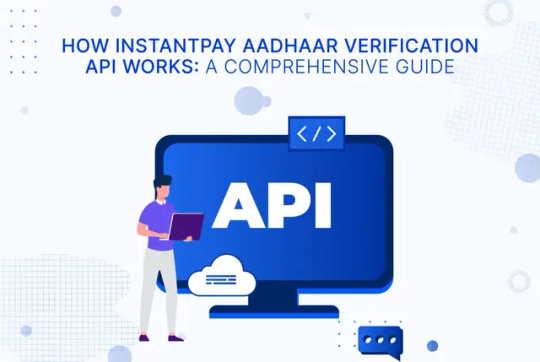
Aadhaar verification has become a cornerstone of identity verification processes in India and is integral to numerous administrative and financial transactions. With over a billion people enrolled, the Aadhaar system is the world's most extensive biometric ID system. This guide provides a detailed understanding of Aadhaar verification, its benefits, and the verification process, focusing on how the system works.
What is Aadhaar?
Aadhaar is a 12-digit unique identification number issued by the Unique Identification Authority of India (UIDAI). Introduced in 2009, Aadhaar is designed to provide a single, robust, and easily verifiable identity document for residents of India.
Need for Aadhaar Verification
Aadhaar verification, also known as Aadhaar authentication, involves validating an individual’s identity using their Aadhaar number. This process is crucial for ensuring that services, subsidies, and benefits reach the correct recipients, thereby reducing fraud and enhancing security across various sectors such as banking, telecom, and government services.
Types of Aadhaar Verification
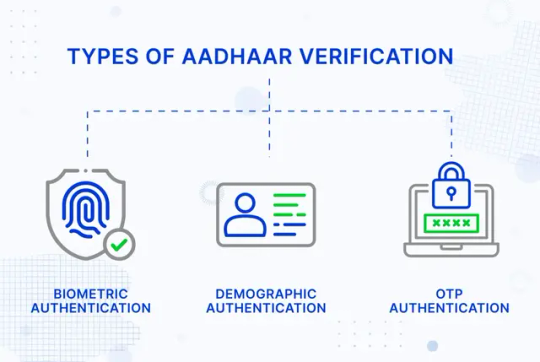
1. Biometric Authentication
To verify identity, biometric authentication uses an individual’s unique physical characteristics, such as fingerprints, iris scans, or facial recognition. This method is highly secure as these biometric traits are unique to each individual and difficult to replicate.
Process:
The individual provides their Aadhaar number.
Biometric data (fingerprints, iris scans, or facial images) is captured using a biometric device.
The captured data is sent to UIDAI for verification against the stored biometric data.
UIDAI responds with a "Yes" or "No" indicating whether the biometrics match the Aadhaar number provided.
2. Demographic Authentication
Demographic authentication verifies an individual's identity using basic demographic information such as name, address, date of birth, and gender. This method is often used in conjunction with biometric authentication to enhance security.
Process:
The individual provides their Aadhaar number along with demographic information.
This information is sent to UIDAI to be verified against the data stored in the UIDAI database.
UIDAI responds with a "Yes" or "No" indicating whether the demographic details match the Aadhaar number provided.
3. OTP Authentication
One-Time Password (OTP) authentication involves sending a unique code to the individual’s mobile number registered with Aadhaar. This method adds an extra layer of security to the verification process.
Process:
The individual provides their Aadhaar number.
An OTP is sent to their registered mobile number.
The individual enters the OTP to complete the verification process.
UIDAI verifies the OTP and responds with a "Yes" or "No".
Learn More:
Everything You Need To Know About Aadhaar Verification
The Role of Aadhaar-PAN Linkage in Securing Identity & Compliance Across Industries
Identity Verification - How to Check PAN Aadhaar Linking Status with API
Aadhaar Verification Using API
What is an API?
An Application Programming Interface (API) is a set of protocols and tools that enable different software applications to communicate and interact with each other. APIs allow systems to share data and functionalities seamlessly, facilitating integration and automation. In the context of Aadhaar verification, APIs serve as a bridge between an organization's application and the UIDAI's Aadhaar database. This connection allows real-time verification of an individual's identity by cross-referencing the provided Aadhaar number and associated data with the UIDAI's records.
How are APIs used?
APIs can be used in numerous ways to enhance various processes across different industries. For instance, an API can retrieve essential information from a database, such as names and addresses, based on specific input criteria. On the other hand, more advanced APIs can provide comprehensive details, including biometrics or transaction histories, using multi-factor authentication methods like OTPs. These APIs ensure secure, quick, and reliable data exchange, making them invaluable tools for banking, telecommunications, healthcare, and e-commerce sectors. By integrating APIs, organisations can streamline operations, improve user experience, and maintain high security and efficiency standards.
Critical Key Terms in APIs
1. Request
The request is the message sent by the client to the server to perform an action (like retrieving or sending data)
2. Response
The response is the message sent back from the server to the client, indicating the result of the request.
3. API Endpoint
A specific URL where the API can access a resource or perform an action.
Example: Aadhaar Verification API
4. API HTTP Methods
Defines the type of operation the client wants to perform:
GET: Retrieve data.
POST: Create new data.
PUT: Update existing data.
DELETE: Remove data.
5. Header
Part of the request and response carries additional information such as content type, authentication tokens, and other metadata.
6. Parameters
Data is sent with the request to specify details or modify the request.
7. Authentication
Methods to verify the client's identity, make the request, and ensure they have the correct permissions. Standard methods include API keys, tokens, and Auth.
What is a REST API or RESTful?
A REST API (Representational State Transfer API) is a web service architecture that uses standard HTTP methods (GET, POST, PUT, DELETE) to interact with URL-identified resources. REST APIs are stateless, meaning each request contains all the information needed for processing. They are known for their simplicity, scalability, and flexibility in handling various data types.
What is API Testing and How Do We Test It?
API testing ensures APIs meet functionality, reliability, performance, and security expectations. Key methods include:
1. Unit Testing: Testing individual endpoints.
2. Integration Testing: Ensuring multiple API calls work together.
3. Performance Testing: Checking response times and load handling.
4. Security Testing: Protecting against unauthorised access.
What is an API Key and Why is it Important?
An API key is a unique identifier used to authenticate a client requesting an API. It ensures only authorised users can access resources, helps track usage, manage quotas, and prevent abuse.
What is Web API and Why is it Beneficial?
A Web API is an API accessed via the web using HTTP protocols. It allows different applications to communicate and exchange data over the internet. Benefits include:
1. Integration: Seamlessly connects systems and applications.
2. Accessibility: Accessible from any internet-connected device.
3. Scalability: Handles increasing loads and user demands.
4. Reusability: Leverages existing functionalities without rebuilding.
What is API Integration?
API integration connects different applications and systems via APIs, enabling them to share data and work together. It automates processes, improves data accuracy, and enhances functionality, creating efficient and scalable digital ecosystems.
Aadhaar Verification APIs on Instantpay
Instantpay offers seamless integration of Aadhaar verification through its APIs, making the verification process efficient and secure for businesses.
1. Aadhaar Demographics API
The Aadhaar Demographics API provides basic demographic information using only the Aadhaar number as input. This API is useful for simple identity verification where detailed information is not required.
Technical Workflow:
Request: The client system sends an HTTP request to the Aadhaar Demographics API endpoint with the Aadhaar number.
Processing: UIDAI processes the request and retrieves demographic details.
Response: The API returns a JSON response containing the demographic information (e.g., name, address, date of birth, gender).
2. Aadhaar offline e-KYC API
The Aadhaar offline e-KYC API provides comprehensive details but requires both the Aadhaar number and an OTP sent to the Aadhaar-linked mobile number. This ensures thorough verification for services needing extensive identity details.
Technical Workflow:
Request: The client system sends an HTTP request to the Aadhaar OKYC API endpoint with the Aadhaar number.
OTP Generation: UIDAI sends an OTP to the registered mobile number.
OTP Verification: The client system captures the OTP and sends it back to the API.
Processing: UIDAI processes the request, fetching both demographic and biometric details.
Response: The API returns a detailed JSON response containing all relevant information (e.g., name, address, date of birth, gender, photograph).
Step-by-Step Guide to Aadhaar Verification on the Instantpay Dashboard
Step 1: Log in to the Instantpay Dashboard and Navigate to Verification Suite. (If this isn't visible, please get in touch with [email protected] to enable it.)
Step 2: Click on the Verify Data Tab
Step 3: Choose Aadhaar Demographic API
Step 4: Download and fill template for Bulk Verification
Or If you want to try out the API click the button below
Step 5: Enter the Aadhaar Number you want to Verify
Step 6: Enter your iPin for authentication
Step 7: Congratulations, you have successfully retrieved the Aadhaar Demographic Data
Step 8: You can view and download the bulk verification files by clicking on the “Download” Button

Who Can Use Aadhaar Verification APIs?
Aadhaar Verification APIs can be utilised by a various organisations and sectors to streamline their identity verification processes. These APIs provide a reliable and secure way to verify the identities of individuals, ensuring that only genuine people can access services and benefits. Here are five examples of entities that can benefit from using Aadhaar Verification APIs:
1. Banks and Financial Institutions
Banks and financial institutions can use Aadhaar Verification APIs to verify customers' identities during account opening, loan applications, and other financial transactions. This ensures compliance with KYC (Know Your Customer) regulations and helps prevent identity fraud.
Example A bank uses the Aadhaar Offline EKYC API to verify the identity of a new customer applying for a savings account. The customer provides their Aadhaar number and OTP, allowing the bank to quickly and securely verify their details and open the account.
2. Telecom Companies
Telecom companies can utilise Aadhaar Verification APIs to authenticate customers when new SIM cards or mobile connections are issued.This process helps prevent fraudulent activities and ensures that mobile connections are issued to legitimate users.
Example: A telecom company uses the Aadhaar Demographics API to verify a customer's identity when they apply for a new SIM card. By entering their Aadhaar number, the company can instantly retrieve and verify the customer's demographic information.
3. Government Agencies
Government agencies can use Aadhaar Verification APIs to authenticate beneficiaries of various schemes and services. This ensures that subsidies and benefits are disbursed to the right individuals, reducing the risk of fraud and providing efficient service delivery.
Example
A government welfare department uses the Aadhaar Verification API to verify the identity of individuals applying for a social welfare scheme. This helps ensure that only eligible beneficiaries receive the benefits.
4. E-commerce Platforms
E-commerce platforms can leverage Aadhaar Verification APIs to verify the identities of sellers and buyers, enhancing trust and security in online transactions. This helps prevent fraudulent activities and builds trust among users.
Example
An e-commerce platform uses the Aadhaar Demographics API to verify the identity of a new seller registering. This ensures that only legitimate sellers can list their products, improving the platform's credibility.
5. Educational Institutions
Educational institutions can use Aadhaar Verification APIs to verify students' identities during admissions and examinations. This helps maintain the integrity of the admission process and ensures that only eligible students are enrolled and assessed.
Example
A university uses the Aadhaar offline - KYC API to verify the identity of applicants during the admission process. Using the Aadhaar number and OTP, the university can authenticate the students' details and ensure that only genuine applicants are admitted.
These examples illustrate the versatility and utility of Aadhaar Verification APIs by Instantpay across various sectors. By integrating these APIs, organisations can enhance security, improve efficiency, and ensure that services and benefits are delivered to the right individuals.

Conclusion
By focusing on how Aadhaar verification works and its implementation through APIs, this guide aims to provide a comprehensive understanding of the process and its significance in various sectors. For detailed API documentation, visit Instantpay Developer Portal, and for further assistance, contact support at [email protected].
0 notes
Text
Explore The Power of Identity Verification with Instantpay's RC Verification in 2024

In today's digital age, identity verification has become integral to various online transactions and services. Whether opening a bank account, applying for a loan, or accessing online platforms, verifying one's identity is crucial for security and compliance. With the advancement of technology, identity verification methods have evolved, offering more efficient and secure solutions.
Understanding Identity RC Verification
Simply put, RC verification involves checking the legitimacy of an RC issued by a regional transport authority (RTA) against official records. This process validates the vehicle's existence, ownership details, and other crucial information, reducing the risk of fraud and promoting transparency in transactions.
Instantpay, a leading modern business banking company, offers a cutting-edge identity verification solution called Identity RC Verification. This innovative solution leverages advanced technology to streamline identity verification while ensuring the utmost security and accuracy.
Why is RC Verification Important?
The importance of RC verification cannot be understated. Here are some key benefits it offers:
Fraud Prevention: Verifying RCs helps safeguard against fraudulent activities like using stolen vehicles or falsifying ownership documents. This mitigates financial losses and protects your business reputation.
Regulatory Compliance: Many industries, including automotive and logistics, are subject to regulations that mandate RC verification for specific transactions. A reliable verification system ensures compliance with these regulations and avoids legal repercussions.
Streamlined Operations: Manual RC verification can be time-consuming and error-prone. Automating the process through an API like Instantpay's RC Verification API significantly speeds up operations and improves efficiency.
Enhanced Customer Experience: Ensuring accurate and timely verification provides a smoother and more secure experience for your customers, fostering trust and satisfaction.
Key Features of Identity RC Verification

Instantpay's Identity RC Verification harnesses the power of artificial intelligence (AI) to conduct real-time identity verification. This ensures the verification process is swift, seamless, and without any delays.
The system can analyze and process vast amounts of data rapidly through AI integration, allowing for instant verification results.

The platform offers advanced document verification capabilities, allowing users to upload various identity documents, such as passports, driver's licenses, and ID cards.
Utilizing optical character recognition (OCR) technology, the system can extract relevant information from uploaded documents accurately and efficiently.

Identity RC Verification incorporates facial recognition technology to match the individual's facial features with the photo on their identity document.
Biometric matching algorithms compare biometric data, such as fingerprints or iris scans, against stored records to verify the person's identity accurately.

The platform implements multi-factor authentication (MFA) mechanisms to bolster security, requiring users to provide multiple verification forms before accessing the system.
MFA may include a combination of factors such as passwords, SMS codes, biometric data, or security questions, adding layers of protection against unauthorised access.

Identity RC Verification offers customisable verification workflows, allowing businesses to tailor the verification process to their specific requirements.
Administrators can define rules and criteria for identity verification, such as the documents accepted, the sequence of verification steps, and the threshold for approval.

The platform conducts comprehensive compliance checks to ensure adherence to regulatory standards such as KYC (Know Your Customer) and AML (Anti-Money Laundering) regulations.
By automating compliance checks, businesses can mitigate the risk of regulatory violations and penalties while maintaining compliance with industry standards.

Identity RC Verification is designed to easily handle high volumes of verification requests, making it suitable for businesses of all sizes.
The platform's scalability ensures it can accommodate growing verification needs without compromising performance or reliability.

For transparency and accountability, Identity RC Verification maintains detailed audit trails of all verification activities, including timestamps, user actions, and verification outcomes.
Administrators can generate comprehensive reports and analytics to gain insights into verification trends, compliance metrics, and system performance.

The platform offers cloud-based deployment options, enabling businesses to access identity verification services securely over the Internet.
Additionally, Identity RC Verification provides robust API integration capabilities, allowing seamless integration with existing systems, applications, and third-party services.

Leveraging machine learning algorithms, Identity RC Verification continuously learns and adapts to new verification patterns, emerging threats, and evolving regulatory requirements.
This ensures that the platform remains effective and up-to-date in detecting and preventing fraudulent activities while maintaining high accuracy and reliability.
Instantpay's Identity RC Verification offers a comprehensive suite of features and capabilities to streamline identity verification, enhance security, and ensure compliance with regulatory standards. By leveraging advanced technologies such as AI, biometrics, and machine learning, businesses can achieve efficient, accurate, and reliable identity verification outcomes while delivering a seamless user experience to their customers and clients. Read more on Instantpay's comprehensive suit of Identity verification - https://blog.instantpay.in/2023/10/12/introducing-instantpay-identity-verification-a-complete-guide/
Functionalities of the Vehicle RC Verification API
[wptb id=2780]
The API is a valuable tool for various industries and use cases, such as insurance companies, law enforcement agencies, vehicle buyers, and sellers, as it enables them to quickly and accurately verify the authenticity and status of a vehicle's registration. By integrating the Vehicle RC Verification API into their applications or systems, users can streamline processes related to vehicle information retrieval and enhance their decision-making processes.

Enhanced Security Measures:
Identity RC Verification employs advanced security measures to safeguard sensitive information and prevent unauthorised access. Businesses can significantly reduce the risk of identity theft, fraud, and data breaches by implementing robust encryption protocols, multi-factor authentication, and biometric verification.
With stringent security measures, Identity RC Verification provides peace of mind to businesses and their customers, ensuring that confidential information remains always protected.
Streamlined Compliance Processes:
Compliance with regulatory standards such as KYC (Know Your Customer) and AML (Anti-Money Laundering) regulations is essential for businesses operating in regulated industries. Identity RC Verification helps streamline compliance processes by automating identity verification procedures and ensuring adherence to regulatory requirements.
By automating compliance checks and maintaining comprehensive audit trails, businesses can demonstrate compliance with regulatory standards and mitigate the risk of non-compliance penalties.
Real-Time Verification:
Identity RC Verification offers real-time identity verification capabilities, allowing businesses to verify customer identities instantly. This eliminates the need for manual verification processes, reducing delays and improving operational efficiency.
With real-time verification, businesses can onboard customers quickly, accelerate transaction processing times, and deliver a seamless user experience.
Cost Savings and Operational Efficiency:
By automating identity verification processes, Identity RC Verification helps businesses save time and resources, leading to cost savings and improved operational efficiency. Manual verification processes are labor-intensive and time-consuming, requiring significant workforce and resources.
With Identity RC Verification, businesses can automate repetitive tasks, reduce manual errors, and streamline verification workflows, resulting in lower operational costs and increased productivity.
Improved Fraud Detection and Prevention:
Identity RC Verification utilizes advanced fraud detection algorithms and machine learning techniques to detect and prevent real-time fraudulent activities. The platform can identify suspicious behaviour and flag potentially fraudulent transactions by analysing patterns, anomalies, and risk factors.
By leveraging predictive analytics and behavioural biometrics, Identity RC Verification helps businesses stay ahead of emerging threats and protect against financial losses due to fraud.
Scalability and Flexibility:
Identity RC Verification is designed to scale seamlessly to accommodate growing verification needs and evolving business requirements. Whether businesses are processing a few hundred verifications per month or millions, the platform can scale up or down effortlessly to meet demand.
Additionally, Identity RC Verification offers flexibility in deployment options, allowing businesses to choose between cloud-based or on-premises deployments based on their preferences and infrastructure requirements.
Enhanced Customer Experience:
By providing a seamless and user-friendly verification experience, Identity RC Verification enhances the overall customer experience. Simplified verification processes, intuitive user interfaces, and quick response times increase customer satisfaction.
With Identity RC Verification, businesses can reduce customer friction during onboarding, improve conversion rates, and foster long-term customer loyalty and retention.
Identity RC Verification offers businesses a wide range of benefits, including enhanced security, streamlined compliance processes, real-time verification, cost savings, improved fraud detection and prevention, scalability, flexibility, and enhanced customer experience. By leveraging advanced technologies and automation from Instantpay, businesses can achieve efficient, accurate, and reliable identity verification outcomes while strengthening operational efficiency and customer satisfaction.
How Vehicle RC Verification API Works
Integration with Transport Authority Databases: The Vehicle RC Verification API integrates with databases maintained by transport authorities or regulatory bodies responsible for vehicle registration and documentation. These databases contain comprehensive records of registered vehicles, including their registration details, ownership information, and compliance status.
Input Parameters: Developers can interact with the Vehicle RC Verification API by passing specific input parameters, typically the vehicle's registration number, through their application or system. The registration number is the unique identifier for the car whose details are being verified.
Real-Time Validation: Upon receiving the input parameters, the Vehicle RC Verification API initiates a real-time validation process by querying the connected transport authority database. The API utilises secure communication protocols to retrieve the relevant information associated with the provided registration number.
Data Extraction: The API retrieves and extracts the corresponding information from the transport authority database based on the input parameters provided. This information typically includes the vehicle's make and model, registration date, chassis number, engine number, owner's name, address, and registration status.
Seamless Processing: The vehicle RC verification process facilitated by the API is seamless and efficient, ensuring minimal latency and quick response times. The API's streamlined workflow and optimised data retrieval mechanisms enable developers to integrate vehicle verification capabilities into their applications or systems seamlessly.
Instant Results: Upon successful validation and data extraction, the Vehicle RC Verification API returns the verified information to the requesting application or system in real time. This instant feedback lets users access accurate vehicle details promptly, facilitating informed decision-making and enhancing operational efficiency.
Secure Communication: The Vehicle RC Verification API prioritizes data security and privacy throughout the verification process. It employs robust encryption protocols and certain communication channels to safeguard sensitive information exchanged between the API and the transport authority database. This ensures that confidential vehicle details remain protected against unauthorised access or tampering.
Scalability and Reliability: The API is designed to accommodate varying levels of usage and traffic demands, ensuring scalability and reliability. Whether processing a few requests or handling high volumes of verification queries, the API maintains consistent performance and availability to meet user needs effectively.
The Vehicle RC Verification API streamlines the process of verifying vehicle registration details by seamlessly integrating with transport authority databases, accepting input parameters, initiating real-time validation, extracting relevant information, and delivering instant results. Its secure, efficient, and scalable architecture empowers developers to incorporate robust vehicle verification capabilities into their applications or systems, enhancing operational efficiency and facilitating informed decision-making.
Challenges in Implementing Vehicle RC Verification API
Data Availability and Integration: Accessing comprehensive and up-to-date vehicle registration databases from transport authorities or regulatory bodies can pose a significant challenge. Integration with these databases requires establishing partnerships and protocols to ensure seamless data exchange. Additionally, inconsistencies in data quality and accessibility across different regions may further complicate the integration process.
Data Privacy and Security: Handling sensitive vehicle information, including registration details and ownership records, necessitates robust data privacy and security measures. Implementing stringent encryption protocols, access controls, and authentication mechanisms is crucial to safeguarding against unauthorised access, data breaches, and identity theft. Compliance with regulatory standards such as GDPR (General Data Protection Regulation) adds another layer of complexity to ensuring data security and privacy.
Standardisation: Coordinating with multiple transport authorities or regulatory bodies to maintain a standardised data structure and format poses a significant challenge in API implementation. Each source may have its own data schema, terminology, and design for storing vehicle registration information, leading to consistency and interoperability issues. Establishing uniform standards and protocols for data exchange and integration is essential to ensure seamless interoperability and compatibility across different systems and jurisdictions.
Data Accuracy and Reliability: Ensuring the accuracy and reliability of the data retrieved from vehicle registration databases is paramount for the effective functioning of the API. Challenges such as outdated or incomplete records, data duplication, and inconsistencies in data entry can compromise the reliability of verification results. Implementing data validation mechanisms, error handling protocols, and periodic data updates is essential to mitigate these challenges and maintain data integrity.
Scalability and Performance: As the volume of verification requests increases, ensuring the scalability and performance of the API becomes crucial. Scaling infrastructure resources, optimising query processing algorithms, and implementing caching mechanisms are essential strategies to handle spikes in demand and maintain optimal response times. Balancing scalability with cost-effectiveness and resource utilisation adds complexity to API implementation and management.
Regulatory Compliance: Adhering to regulatory requirements and compliance standards governing vehicle registration data collection, storage, and processing poses additional challenges. Compliance with regulations such as the Motor Vehicles Act, data protection laws, and industry-specific guidelines requires thorough legal and regulatory analysis and ongoing monitoring and updates to ensure compliance with evolving requirements.
User Experience and Accessibility: Providing a seamless user experience and ensuring accessibility across various platforms and devices is essential for the widespread adoption of the API. Designing intuitive user interfaces, optimizing API endpoints for performance, and supporting multiple authentication methods are critical considerations to enhance usability and accessibility for developers and end-users.
Implementing a Vehicle RC Verification API entails overcoming various challenges related to data availability and integration, data privacy and security, standardisation, data accuracy and reliability, scalability and performance, regulatory compliance, and user experience.
Addressing these challenges requires a comprehensive approach encompassing technical, regulatory, and operational considerations to ensure the successful deployment and operation of the API.
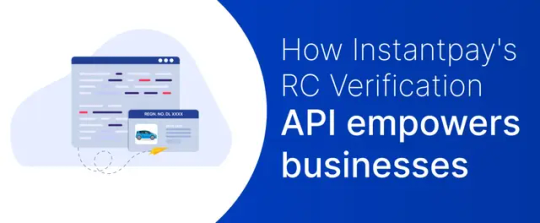
Instantpay's RC Verification API is a powerful tool to simplify and streamline your RC verification process.
Here's what it offers:
Comprehensive Data Retrieval: The API facilitates comprehensive data retrieval by extracting key information from the Registration Certificate (RC). This includes vehicle details such as make, model, year of manufacture, engine specifications, owner information, registration status, and more. By providing access to a wide range of data points, the API offers users a holistic view of the vehicle's registration status and ownership details, enabling informed decision-making and regulatory compliance.
Real-time Verification: Users can leverage the API to perform real-time verification of the RC against official Regional Transport Authority (RTA) records. By accessing up-to-date data directly from the RTA database, the API delivers instant results on the validity of the RC, minimising delays and enabling prompt decision-making. This real-time verification capability enhances operational efficiency and reduces the risk of relying on outdated or inaccurate information.
Nationwide Coverage: The API provides national coverage, allowing users to verify RCs issued by any RTA across India. This ensures comprehensive coverage and accessibility regardless of the vehicle's location or the issuing authority. Whether the RC originates from a metropolitan city or a rural area, the API offers seamless verification capabilities, facilitating nationwide compliance and operational consistency.
Seamless Integration: With its seamless integration capabilities, the API can easily integrate with existing systems and applications. Whether it's a web-based platform, mobile app, or enterprise software, the API's flexible architecture allows quick and effortless implementation. By seamlessly integrating with existing workflows and processes, the API enhances operational efficiency and user experience, minimising disruptions and maximising productivity.
Security and Compliance: Instantpay prioritises security and compliance by adhering to stringent security standards and data privacy regulations. The API ensures the safe and ethical handling of sensitive information, including vehicle registration and owner information. By implementing robust security measures such as encryption, access controls, and audit trails, Instantpay safeguards data integrity and confidentiality, earning users' trust and confidence in the platform's reliability and compliance posture.
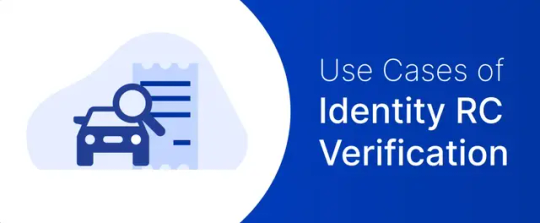
Financial Services: Banks, fintech companies, and other financial institutions can use Identity RC Verification to onboard customers, verify identities for loan applications, and comply with regulatory requirements.
E-commerce: E-commerce platforms can implement Identity RC Verification to verify customers' identities during registration and checkout, reducing the risk of fraudulent transactions.
Healthcare: Healthcare providers and telemedicine platforms can utilize Identity RC Verification to verify patients' identities, ensuring secure access to medical records and health services.
Gaming and Entertainment: Online gaming and entertainment platforms can integrate Identity RC Verification to verify users' identities, preventing underage access and unauthorised activities.
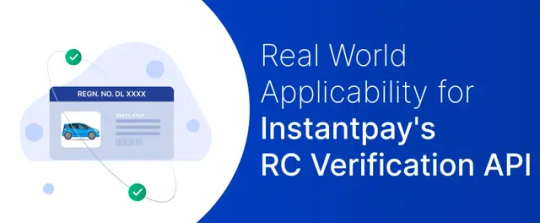
The use cases for Instantpay's RC Verification API are diverse, benefiting businesses across various industries. Here are some real-world examples:
Car dealerships: Instantly verify customer-provided RCs during vehicle purchases, preventing fraud and streamlining transactions.
Rental companies: Ensure the legitimacy of RCs submitted by car renters, providing peace of mind and mitigating theft risks.
Logistics providers: Verify vehicles' ownership and registration status before accepting them for transport, ensuring compliance and safety.
Finance companies: Conduct due diligence on vehicle ownership during loan applications, minimising financial risks and fraudulent activities.
Traffic Authorities: Traffic police and law enforcement agencies can instantly employ the API to retrieve vehicle information during routine checks or investigations.
Insurance Companies: Insurance providers can integrate the API into their claims processing systems to validate vehicle information and prevent fraud.
These are just a few examples, and the possibilities are endless. By integrating Instantpay's RC Verification API, businesses can achieve:
Reduced Fraud: By verifying the authenticity of RCs, businesses can significantly reduce the risk of fraud and associated financial losses.
Increased Efficiency: Automating the verification process saves time and effort, allowing employees to focus on other critical tasks.
Improved Compliance: Adhering to regulations becomes easier with instant and accurate verification, eliminating compliance concerns.
Enhanced Customer Satisfaction: Faster and more secure transactions lead to happier customers who trust your business practices.
Instantpay's Identity RC Verification offers a sophisticated and reliable solution for businesses seeking to streamline their identity verification processes. With its advanced features, robust security measures, and compliance capabilities, Identity RC Verification is poised to revolutionise how businesses verify identities in the digital age. By leveraging this innovative solution, companies can enhance security, improve efficiency, and deliver a seamless user experience to their customers and clients.
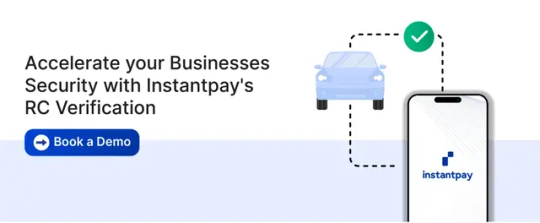
0 notes
Text
Demystifying Bank Account Verification APIs in 2024

BANK ACCOUNT VERIFICATION API- In this era where technological advancements have guided in unprecedented opportunities through the years. They have also brought forth new avenues for deception and illicit activities or what we call in simpler terms fraudulent activities.
Throughout business operations, safeguarding against frauds stands as a paramount concern, particularly when it comes to verifying the authenticity of bank accounts belonging to customers or partners.
READ - https://blog.instantpay.in/2023/10/12/introducing-instantpay-identity-verification-a-complete-guide/

During the first half of the ongoing fiscal year 2023-2024, the banking sector witnessed a significant surge in fraudulent activities, with reported cases totalling 14,483, marking a notable increase. However, despite this rise in the number of incidents, the financial impact amounted to only 14.9 percent of the previous year's total.
According to the Reserve Bank of India's "Trends and Progress of Banking in India 2022-23" report, there's a pressing necessity to safeguard both the banking system and the payments infrastructure against the looming threats posed by cyber fraud and data breaches.
The reported fraud cases amounted to Rs 2,642 crore during this period, compared to 5,396 cases involving Rs 17,685 crore in the corresponding period of the preceding year.
Let’s paint a picture of the perspective of an e-commerce platform striving to guarantee the legitimacy of bank account details provided by sellers for payout purposes, or envision a financial service provider tasked with verifying the bank information of clients to facilitate secure transactions. In both scenarios, ensuring the accuracy and validity of bank account information emerges as an indispensable measure, serving not only to prevent potential fraud but also to mitigate errors and uphold the bedrock of trust upon which successful business relationships are built.
Given the gravity of this endeavor, a meticulously crafted plan of action is imperative. This plan must encompass a multifaceted approach that leverages cutting-edge technological solutions while adhering to rigorous verification protocols. At its core, such a strategy would involve the deployment of sophisticated identity verification mechanisms capable of scrutinising bank account details with unparalleled precision. This could entail the utilisation of advanced algorithms to cross-reference provided information against authoritative databases, thereby validating the authenticity of bank accounts with a high degree of accuracy.
Furthermore, the plan would necessitate the implementation of stringent verification procedures, encompassing robust authentication measures such as two-factor authentication (2FA) and biometric identification. By incorporating these layers of security, businesses can fortify their defenses against fraudulent activities while instilling confidence among stakeholders regarding the integrity of their financial transactions.
India has seen a subsequent rise in the overall fraud through the years
In order to prevent frauds, bank account verification APIs come into play. These powerful tools enable businesses to seamlessly Verify Bank Account details, Ensuring Accuracy and Security in Financial Transactions.
In this blog, we'll delve into the world of bank account verification APIs, exploring their benefits, functionality, and how they revolutionise banking and business operations.
What is Bank Account Verification API?
Bank Account Verification API is a sophisticated application programming interface that enables businesses to verify the authenticity and validity of bank accounts in real-time. It acts as a bridge between businesses and financial institutions, allowing seamless communication and verification of crucial banking information.
Understanding Bank Account Verification APIs
Bank account verification APIs offer a streamlined solution for businesses to validate the authenticity of bank account information provided by customers or partners. These APIs leverage advanced algorithms and access to banking databases to verify the accuracy of account numbers, account holders' names, and other relevant details. By integrating with these APIs, businesses can automate the verification process, saving time and resources while enhancing security measures.
Why do we need a Bank Account verification API
Verifying bank accounts plays a pivotal role in both Know Your Customer (KYC) and Anti-Money Laundering (AML) procedures.
The necessity for this verification stems from several key reasons.
[wptb id=2719]
Instantpay - A Trusted API Partner
In the realm of bank account verification APIs, Instantpay emerges as a standout provider, offering businesses a comprehensive solution to streamline their verification processes. With its cutting-edge technology and user-friendly interface, Instantpay empowers businesses to verify bank account details with unprecedented speed and accuracy.
Instantpay's API is designed with the needs of businesses in mind, offering a range of features and customisation options to suit diverse requirements.
From getting bank lists to verifying UPI Handle, Instantpay's API provides businesses with the flexibility and reliability they need to ensure the integrity of their financial transactions.
Moreover, Instantpay's commitment to security and compliance sets it apart as a trusted partner in the realm of bank account verification. With robust encryption protocols and adherence to regulatory standards, Instantpay ensures that businesses can verify bank account details with confidence, knowing that their data is protected and their operations are compliant with relevant regulations.
In addition, Instantpay distinguishes itself through its dedication to customer satisfaction. With responsive support and ongoing updates and improvements, we work closely with businesses to address their needs and enhance their verification processes.
Overall, Instantpay stands out as a leading provider of bank account verification APIs, empowering businesses to verify bank account details with speed, accuracy, and confidence. With its advanced technology, commitment to security, and focus on customer satisfaction.
Use Cases and Examples
1. E-commerce Platforms:
E-commerce platforms play a crucial role in facilitating online transactions between buyers and sellers. By integrating bank account verification APIs, these platforms can enhance trust and transparency in their transactions.
Through the use of bank account verification APIs, e-commerce platforms not only verify the authenticity of sellers' bank account details but also streamline the payout process, ensuring sellers receive their funds securely and promptly.
Moreover, the integration of Bank List APIs allows these platforms to offer a wide range of payment options to their users, enhancing convenience and flexibility in bill payments, subscription renewals, and other financial transactions.
2. Financial Services:
Banks, fintech companies, and other financial institutions often deal with crucial data, and by leveraging bank account verification APIs they enhance the reliability and efficiency of their services. Whether it's opening a new account, initiating fund transfers, or conducting routine transactions, verifying customer bank account details is essential to prevent fraud and ensure compliance with regulatory standards.
By integrating bank account verification APIs into their systems, financial service providers can automate and streamline the account verification process, reducing manual errors and enhancing the overall customer experience. This not only improves operational efficiency but also instils confidence among customers in the security of their financial transactions.
3. Subscription Services:
Subscription-based businesses rely on recurring payments to sustain their revenue streams and provide continuous access to their services. However, managing subscription payments efficiently while preventing fraudulent activities can be challenging.
Bank account verification APIs offer a robust solution for subscription-based businesses to verify the authenticity of customer payment methods. By validating bank account details during the subscription signup process, these businesses can ensure that only legitimate customers can access their services. Moreover, by periodically re-verifying bank account information, they can prevent unauthorized access and minimize revenue leakage due to failed payments or chargebacks.
Additionally, integrating bank account verification APIs can streamline the subscription billing process, reducing administrative overhead and improving cash flow management for the business. This enables subscription-based businesses to focus on delivering value to their customers while maintaining the integrity and security of their payment systems.
Conclusion
As we look ahead, the role of bank account verification APIs will only continue to grow in significance. With advancements in technology and increased adoption across industries, these APIs will empower businesses to navigate the complexities of financial transactions with confidence and ease. By leveraging the power of automation, data integrity, and regulatory compliance, businesses can forge ahead into a future where secure transactions are not just a necessity but a cornerstone of success.
As we've explored throughout this blog, we have come to understand that bank account verification APIs represent more than just a technological tool—they symbolise a commitment to transparency, reliability, and trustworthiness in the digital realm. As businesses strive to innovate and adapt to changing landscapes, the adoption of these APIs will undoubtedly remain at the forefront of their strategies for sustainable growth and success.
Instantpay is your reliable API partner, offering comprehensive Financial Verification APIs tailored to meet your business requirements. Our commitment to innovation drives us to redefine how businesses verify bank account information and facilitate secure financial transactions seamlessly.
Get Started Today !
FAQ
How to Verify a Bank Account Using an API
Bank account verification through APIs offers a streamlined and secure method for businesses to authenticate bank account details. By integrating with a bank's API, businesses can verify account ownership, validity, and other pertinent details in real-time, ensuring accuracy and reliability in financial transactions.
What are the benefits of Bank Account Verification API
1. Enhanced Security: Bank account verification APIs provide robust authentication mechanisms, minimizing the risk of fraudulent activities and unauthorized access to financial resources. By ensuring the accuracy of bank account details, businesses can safeguard against potential breaches and protect sensitive information.
2. Improved Operational Efficiency: Automation of the verification process via APIs reduces manual intervention, leading to faster processing times and improved operational efficiency. Businesses can streamline workflows, allocate resources effectively, and focus on core activities, thereby enhancing productivity and performance.
3. Cost Savings: API-driven bank account verification eliminates the need for manual verification processes, reducing overhead costs associated with labor and administrative tasks. By minimizing errors and optimizing resource utilization, businesses can achieve significant cost savings and allocate resources more efficiently.
4. Regulatory Compliance: Compliance with regulatory standards such as Know Your Customer (KYC) and Anti-Money Laundering (AML) regulations is facilitated through API-based verification processes. By ensuring adherence to regulatory requirements, businesses can mitigate compliance risks and maintain a favorable reputation within the industry.
5. Enhanced Customer Experience: Accurate and secure bank account verification enhances the overall customer experience by instilling trust and confidence in financial transactions. By prioritizing data integrity and security, businesses can cultivate long-term relationships with customers, driving loyalty and retention.
What are the fraud detection Mechanisms Used by Banks?
Banks employ sophisticated fraud detection systems that utilise advanced algorithms and machine learning techniques to identify suspicious activities. These systems analyse transaction patterns, including frequency, amount, and geographic location, to detect anomalies and potential fraudulent behavior. By leveraging data analytics and real-time monitoring, banks can proactively mitigate fraud risks and protect both customers and financial institutions.
What is API Verification?
API verification involves the use of application programming interfaces (APIs) to authenticate and validate user data or transactions. In the context of bank account verification, APIs enable seamless communication between businesses and banking systems, allowing for real-time verification of account details. Through API integration, businesses can access secure and reliable verification services, enhancing the accuracy and efficiency of financial transactions.

0 notes
Text
Top 5 Payment Processing Challenges For SMEs
Payment processing is a critical aspect of any business operation, and for small and medium-sized enterprises (SMEs), overcoming challenges in this domain is crucial for sustaining growth and ensuring financial stability. Managing cash flow and payment processing often comes with its set of challenges, particularly for online and small businesses. Late payments pose a significant hurdle, disrupting regular cash flow and hindering operational capabilities. Ensuring payment security against fraud is a constant concern, necessitating robust measures to protect customer data and prevent unauthorised transactions. The time-consuming process of reconciling payments with invoices can lead to errors, impacting financial reporting.
In this blog, we'll delve into the intricate world of payment processing challenges faced by SMEs and explore how innovative solutions, such as Instantpay, can help businesses tackle these obstacles head-on.
Small and Medium Enterprises (SMEs) face several challenges and pain points when it comes to handling finances.
What are these challenges that can impact the efficiency, growth, and overall financial health of the business ❓
Avoid Them All With Instantpay
Instantpay emerges as a comprehensive solution to the myriad challenges faced by SMEs in payment processing. Our modern, integrated banking prioritise security, technology, and customer service, enabling businesses to optimise online payment processing and access multi-channel payments effortlessly.
[wptb id=2699]
Best Practices
To navigate the intricate realm of digital transactions effectively, businesses must adhere to best practices that not only safeguard financial transactions but also optimise the customer experience.
1. Thorough Research and Choosing the Right Payment Processor:
Selecting a payment processor is a critical decision for small businesses. Instantpay stands out with its proven track record of reliability and competitive rates, making it a top-tier choice. Before making a decision, businesses should thoroughly research and align their specific needs with the features offered by Instantpay.
2. Fortifying Security Measures:
Security is non-negotiable in the digital transaction landscape. Instantpay takes this seriously by incorporating advanced security features, ensuring a secure environment for both businesses and its clientele. By choosing Instantpay, businesses can transact with the confidence that their financial data is well-protected.
3. Expanding Payment Options:
Today's customers have diverse preferences when it comes to payment methods. Instantpay recognises this and supports a broad range of payment options, including credit cards, digital wallets, and more. This flexibility allows businesses to cater to a diverse customer base, enhancing customer satisfaction and increasing conversion rates.
4. Streamlining Integration Processes:
Integration shouldn't be a headache for businesses. Instantpay offers a user-friendly dashboard for payment processes and API plugins that simplify the integration process. This streamlining not only reduces the complexity for businesses but also ensures a seamless connection between payment systems and existing operations.
5. Continuous Learning and Staying Informed:
The payment processing landscape is dynamic, with technologies and trends evolving rapidly. Instantpay goes beyond its role as a payment processor by providing businesses with valuable educational resources. By staying updated on industry trends, businesses can make informed decisions, ensuring they remain competitive and adaptable in the ever-changing marketplace.
Conclusion
In a world where small businesses navigate the challenges of payment processing, Instantpay emerges as a reliable ally. By addressing the top five challenges and offering a robust, secure, and versatile payment processing solution, Instantpay empowers businesses to thrive in the digital economy.
We not only provide a reliable and cost-effective solution for payment processing but also contribute to the overall success of businesses by addressing key challenges and fostering continuous improvement through education and innovation
Connect with our financial experts to delve into the world of Instantpay. Whether you're dealing with one-time transactions or recurring payments, Instantpay has got you covered.
Discover the benefits of swift and secure payment processing. Our team is ready to guide you through the features that make Instantpay the ideal solution for your payment needs.
Say goodbye to the complexities of payment processing and embrace a streamlined and secure solution with Instantpay.
Frequently Asked Questions
How does a payment processor work?
When a customer makes a purchase, the payment processor verifies the transaction details, authorizes the payment, and transfers funds from the customer's account to the merchant's account. This process typically involves encryption for security and various communication channels.
What types of payment methods do processors support?
Payment processors support a wide range of payment methods, including credit cards, debit cards, digital wallets (like PayPal, Apple Pay, or Google Pay), bank transfers, and other alternative payment methods.
What is PCI compliance, and why is it important for payment processors?
PCI compliance refers to adherence to the Payment Card Industry Data Security Standard. It is crucial for payment processors to comply with these security standards to protect sensitive cardholder information and ensure secure transactions.
Differentiating Between Payment Gateways and Payment Processors.
Now, Many businesses often find themselves perplexed when it comes to understanding the roles of payment gateways and payment processors. This confusion can lead to inefficiencies and challenges in managing payment transactions. Let’s demystify these crucial components of business transactions to help you make informed decisions for your business.
Often Payment gateways and payment processors work together to enable smooth transactions, understanding their distinct roles is essential for SMEs to optimise their payment processes effectively. Empowering businesses to make informed decisions when selecting payment service providers and ensures a seamless and secure payment experience for their customers
Payment Gateway:
A payment gateway acts as a bridge between the merchant's website or application and the financial institutions involved in the transaction. Its primary function is to facilitate the communication of payment information securely. Here's a breakdown of the key roles of a payment gateway:
Transaction Initiation: When a customer purchases an online platform, the payment gateway is responsible for initiating the transaction process.
Encryption and Security: The payment gateway encrypts the sensitive information provided by the customer, such as credit card details, to ensure a secure transfer of data over the internet.
Authorisation Request: The encrypted information is sent to the payment processor and the respective credit card network or issuing bank to request authorisation for the transaction.
Transaction Response: Once the authorisation is obtained, the payment gateway receives the response and communicates it back to the merchant's website, indicating whether the transaction was approved or declined.
User Experience: Payment gateways also play a role in enhancing the user experience by providing a seamless and secure payment process, which includes features like a checkout page hosted by the gateway.
In summary, a payment gateway facilitates the flow of information between the customer, the merchant, and the financial institutions involved in processing the payment.
Payment Processor:
While the payment gateway focuses on the communication and authorisation aspects, the payment processor is responsible for the actual movement of funds. Here's a breakdown of the key roles of a payment processor:
Transaction Settlement: Once the payment gateway receives authorisation, the payment processor takes over and settles the transaction by moving funds from the customer's account to the merchant's account.
Funds Transfer: The payment processor handles the movement of money between the customer's bank or credit card account and the merchant's account.
Risk Management: Payment processors often include risk management features, such as fraud detection and prevention, to ensure the security of transactions.
Record Keeping: Payment processors maintain records of transactions, making it easier for merchants to reconcile their accounts and manage financial reporting.
Thus, a payment processor deals with the financial aspects of the transaction, ensuring that the funds are transferred securely and efficiently between the customer and the merchant.
Understand the difference between Payment Gateway & Payment Processor better
https://blog.instantpay.in/2023/03/21/know-the-difference-between-a-payment-gateway-and-a-payment-processor/
How Payment Gateways Interact with Payment Processors?
Transaction Initiation: When a customer makes a purchase, the payment gateway collects the payment information and sends it securely to the payment processor.
Encryption and Authorization: The payment processor decrypts and validates the payment details, checking for available funds and ensuring security. If authorized, the payment processor sends the approval back to the payment gateway.
Transaction Completion: The payment gateway receives the approval and communicates it to the merchant's website or system, allowing the transaction to be completed.
How long does it take for funds to be transferred to a merchant's account? The time it takes for funds to reach a merchant's account can vary depending on the payment processor, the type of transaction, and the banking system. At Instantpay the payment is processed in real time.
0 notes
Text
3 Ways Neobanks are Reshaping Banking for Small Businesses

Recently, the surge in popularity of neobanking and digital banking in India has reshaped the financial services landscape. Fuelled by increased awareness, specialised offerings, and a remarkable adaptability to evolving business needs, neobanks have emerged as the preferred choice for today's businesses.
In this comprehensive blog, we will delve into three pivotal aspects that highlight the profound benefits neobanks bring to small business banking. Let's delve into the details!
Revolutionising Financial Services for Speed and Simplicity
Neobanks redefine the banking experience with streamlined and expedited financial services. Unlike their traditional counterparts, online banking with neobanks involves minimal and simplified procedures. Whether it's opening a new account, processing payments, or reconciling transactions, everything happens in real-time.
The time and effort saved through their uncomplicated infrastructure and swift services are invaluable to businesses. Collaborations with traditional banks further enhance their offerings, providing small and medium enterprises (SMEs) with cutting-edge financial products. A prime example is Instantpay, which consolidates multiple accounts into a unified digital dashboard or mobile app, offering a seamless experience for managing business finances.
Empowering Financial Control with Intuitive Tools
Beyond providing a fully digital banking experience, neobanks equip businesses with powerful tools for enhanced financial control. These include features for easy money movement tracking, insights into incoming and outgoing payments, and efficient employee expense management. The intuitive banking dashboard acts as a centralised hub for managing various financial tasks simultaneously. This capability allows businesses to streamline their financial operations, resulting in improved overall efficiency. Neobanks empower businesses with the tools they need to take charge of their financial well-being.
Automation Throughout Financial Processes
Neobanks offer SMEs cost-effective access to corporate banking services, with a strong emphasis on automating financial operations. From digital onboarding to simplified loan application processes and expedited payment processing, neobanks drive efficiency across the board. Business owners can leverage automation to handle diverse financial aspects, including vendor payments, expense management, and payment collections. Application Programming Interfaces (APIs) facilitate the integration of banking and financial features into company ecosystems, with the option of custom branding for a personalised touch.
The Pros of Neobanks
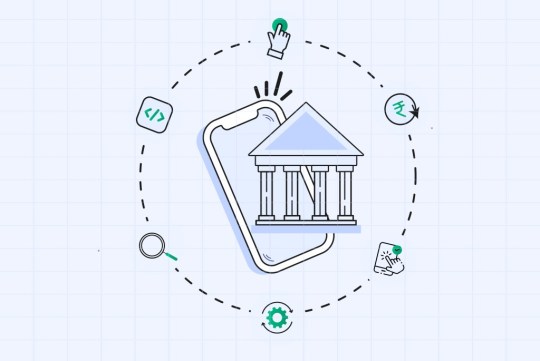
Convenient Access
Neobanks allow customers to handle most of their banking needs on a website or smartphone app 24/7, without visiting a branch. Top neobanks have highly-rated apps that make banking a breeze, like Instantpay.
Opening an account with a neobank can also be simpler than at traditional banks. Some neobanks don't review banking histories, meaning your application is more likely to be approved even if you've had accounts closed previously.
Lower Expenses, Competitive Returns
Like traditional banks, neobanks don't have the overhead of maintaining physical branches, and some pass the savings to customers through low or no monthly fees and strong interest rates on savings.
Superior User Experience
Neobanks don't provide novel banking services by themselves. Their offerings resemble traditional banks, but with a streamlined and personalized user experience. Compared to old-school banks, neobanks have leaner business models and superior technology, enabling seamless account opening, 24/7 chatbot customer service, near real-time international transfers, and AI/ML-powered automated accounting, budgeting and treasury services.
Automated Offerings
In addition to basic banking services, neobanks provide automated, near real-time accounting and reconciliation for tasks like bookkeeping, statements, and tax services including GST-compliant invoicing, payment tracking and reconciliation, all through user-friendly mobile platforms at affordable rates.
Transparency
A major appeal of Neobanks is their commitment to transparency in all operations. Rather than hiding behind fine print, they provide customers with real-time notifications and unambiguous explanations for any fees, charges or penalties applied to their accounts. Neobank users enjoy an unprecedented level of clarity regarding how much they are paying and why, with no hidden costs or surprise gotchas. This refreshing openness helps build trust and confidence in neobanks.
In-Depth Insights
Most Neobanks offer intuitive dashboards and easy-to-understand, valuable insights into services like payments, payables, receivables and bank statements. For businesses with significant expenditures and personnel, these insights can reduce costs, boost productivity and revenue.
Developer-Friendly APIs
Most neobanks provide easy-to-implement and user-friendly APIs to integrate banking services into accounting and payment systems.
Before signing up, review the provider's policies. Some neobanks charge fees for premium services or require a certain transaction volume each month to earn the best interest rates. Make sure the offer aligns with your spending and savings goals.
How Do Neo Banks Work?
Neo banks represent a new breed of financial institutions distinct from traditional and digital banks. Without costly physical branches and large staffs, neo banks efficiently deliver cutting-edge digital banking services.
At their core, neo banks partner with established banks to gain access to capital and regulatory approvals. The neo bank then develops the interface and products, while handling acquisition, service, and the end-to-end customer experience.
This allows neo banks to focus on innovation and customer satisfaction. Their sleek apps and data analytics provide personalised offerings tailored to user behaviors and needs.
Many Neo banks offer attractive accounts with no monthly fees, catering to first-time earners. They also provide lending to businesses looking to expand their operations or build something new.
Leveraging agile development and continuous customer insight, neo banks will shape finance around individuals and businesses like never before.
The Rising Popularity of Neobanks

The digital revolution has disrupted the banking industry, giving rise to a new breed of financial services - Neobanks. These virtual banks are gaining traction globally, especially among tech-savvy millennials and Gen Z.
Convenience and ease of use are huge selling points. Neobanks provide seamless mobile banking with intuitive interfaces. Account opening and money transfers happen in minutes, not days. Customers enjoy 24/7 access and minimal paperwork. The streamlined digital experience attracts digitally native generations.
Transparency is another key advantage. Neobanks have lower fees and no hidden charges compared to traditional banks. Their business models center around customer needs, not profit margins. The transparency builds trust and loyalty.
Innovation is in Neobanks' DNA. They leverage cutting-edge technology like AI, ML, biometrics and blockchain to offer hyper-personalised services and top-notch security. This constant innovation delivers a superior banking experience.
The responsive customer service also scores big. Neobank users have access to real-time support and instant resolution of queries. The human touch blended with digital convenience is a big draw.
In summary, neobanks are winning over customers globally by transforming banking into a seamless, secure and personalised digital experience. Their innovations cater to shifting consumer preferences - the need for speed, transparency and convenience. This perfect storm makes neobanking the future of financial services.
Way Forward
Neobanks have attracted many millennials with their user-friendly online services and excellent accessibility. A smartphone app or desktop is all you need to conduct financial transactions anywhere, anytime. They utilise biometrics and AI technologies to provide advanced products and services to users. With encryption and two-factor authentication, banking is safe and convenient for everyone.
Neobanks are not just financial institutions; they are catalysts for innovation, offering tailored experiences that redefine the landscape of small business banking. With their user-friendly interfaces, cutting-edge technologies, and commitment to security, neobanks like Instantpay are ushering in a new era of accessibility and efficiency in financial services.
Business owners looking to modernise their financial processes can confidently turn to Instantpay for an innovative and effective banking solution. As the neobank revolution continues, the future of small business banking looks more dynamic and promising than ever.
FAQs
What is a Neobank?
Neobanks, also known as digital banks or online-only banks, are digital-first banks that operate without physical branches, relying on mobile apps and online platforms for all services.
What are the benefits of using a Neobank in India?
Neobanking in India merges seamlessly with the global trend, offering a user-centric financial experience. Neobanks in India provide hassle-free account opening processes, rapid transactions, and reduced fees. Their mobile apps cater to the needs of the Indian population, enhancing convenience for on-the-go financial management. These neobanks also offer innovative expense tools that empower users to track and analyse spending efficiently, aligning with the growing tech-savvy demographic in the country.
One notable advantage of neobanking in India is the competitive interest rates they often provide, making them an enticing prospect for individuals and businesses seeking enhanced returns on deposits. This trend contributes to the evolving financial landscape in India, where neobanks play a significant role in reshaping traditional banking norms.
What is the difference between neobank and digital bank?
The terms "neobank" and "digital bank" are often used interchangeably, but there is a nuanced difference. A neobank refers specifically to a financial institution that operates exclusively online, focusing on innovative and user-friendly digital services. On the other hand, a digital bank is a broader concept encompassing both traditional banks with online services and neobanks.
While both emphasise digital accessibility, neobanks are distinct in their pure-play digital approach, prioritising tech-driven solutions and often challenging traditional banking norms, whereas digital banks may include traditional banks adapting to the digital era alongside neobanks.
Is Neobank Safe?
Neobanks in India, subject to RBI oversight, adhere to regulatory standards and implement security measures comparable to those of traditional banks. Reputable ones typically employ robust security protocols such as encryption, two-factor authentication, and secure data storage to protect customer information.
Which documents are necessary for opening a Neobank account? Usually, you only need your Mobile Number, PAN card, and Aadhaar card. Additional verification documents may be requested by certain neobanks.

0 notes
Text
Mastering Business Payouts: Navigating Modern Finances with Instantpay
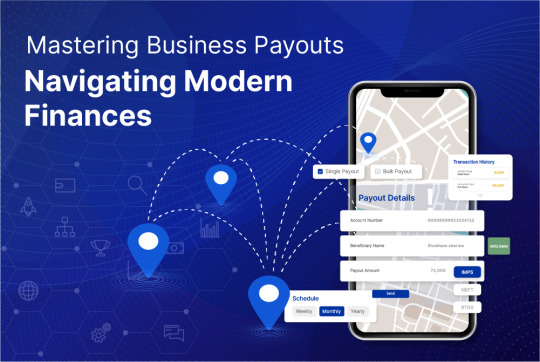
Table of Content | Understanding Business Payouts with Instantpay
What are Payouts and who actually needs them?
Different Payouts for Businesses
How Various Industries Rely on Payouts: Key Use Cases
Challenges Associated with Payouts
Payouts Your Business Needs - Instantpay Payouts
Diving into the Payout APIs with Instantpay
In the vast realm of financial transactions, payouts have emerged as a crucial component, especially for businesses. At its core, a payout is the disbursement of funds from one entity to another. Whether it's a company compensating its suppliers, an e-commerce platform refunding its customers, or a tech startup rewarding its affiliates, the underlying principle remains the same – the timely and accurate transfer of money.
With the digital revolution, the nature of payouts has undergone a significant transformation. Gone are the days of tedious paperwork and long waiting periods. Today's payout systems, bolstered by fintech innovations, promise speed, efficiency, and flexibility. Businesses can now execute bulk payouts, ensuring multiple recipients receive their dues simultaneously, saving time and reducing errors.
Moreover, the integration of analytics in modern payout platforms offers businesses insights into their transactions, aiding in financial planning and decision-making. The transparency and security these platforms provide further instill trust among stakeholders.
In this age, as businesses aim for global reach, having an efficient payout system isn't just an advantage—it's a necessity. It's an embodiment of a company's commitment to its partners, suppliers, and customers, ensuring relationships built on trust and reliability.
Understanding Business Payouts with Instantpay
Every business, whether a large enterprise or an SME, has to process payments. These payments, known as payouts, have become the lifeblood of modern commerce. But what exactly is a payout in the world of payments?
What are Payouts and who actually needs them?
At its essence, a payout is the process of disbursing funds from a business to another entity. This entity could be an individual, such as an employee receiving their salary, a vendor getting paid for their services, or even a customer receiving a refund.
Every business, from small startups to large multinational corporations, requires a system to process these disbursements. E-commerce platforms, for example, need to refund customers. Affiliate marketers require a system to pay their partners. Manufacturers have to compensate their suppliers. In essence, if a business has any monetary obligations outside of its operational costs, it will need a reliable payout system.
Introducing the Payout Product
In the evolving landscape of digital payments, businesses need more than just a method to send money. They require an entire system—a payout product. This system is designed to manage, schedule, and process multiple payouts seamlessly. The aim is to make transactions as smooth and hassle-free as possible, especially when dealing with bulk transactions like bulk payouts.
Why is a Good Payout Solution Essential?
A robust payout solution like Instantpay's Payout Link ensures businesses can meet their financial commitments promptly.
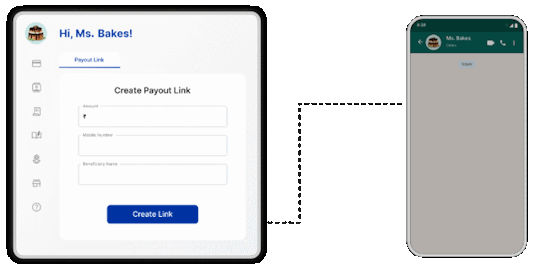
In a digital age, delays can harm reputation, affect trust, and even lead to financial penalties in some sectors. An efficient payout solution:
Reduces Errors: Automated and streamlined processes decrease the chances of transactional errors.
Improves Cash Flow: Faster transactions ensure that funds are available when needed, aiding in better financial planning.
Enhances Trust: Consistent and timely payments foster trust among stakeholders.
How do businesses use a payout solution?
The traditional method of writing checks or making manual bank transfers is cumbersome and fraught with potential errors. Enter modern payout solutions, designed to simplify, streamline, and secure the process. Here's how businesses leverage these systems:
Bulk Payments: When disbursing payments to multiple recipients, businesses can use Bulk Payouts, ensuring each entity is compensated simultaneously, without the hassle of individual transactions.
Refunds: E-commerce platforms and online service providers can efficiently process customer refunds, enhancing customer satisfaction and trust.
Affiliate Compensation: Online platforms can automatically calculate and disburse commissions to partners, ensuring timely payments and maintaining healthy partnerships.
Supplier Compensation: Businesses can ensure their suppliers are paid on time, fostering long-term relationships and smooth operations.
Miscellaneous Payments: From compensating freelancers to disbursing cashbacks, modern payout solutions offer flexibility for a variety of payment needs.
Why is a good payout solution important for business?
Having an efficient payout solution isn't just a convenience—it's a business necessity.
Here's why:
Enhanced Efficiency: Automated processes reduce manual interventions, minimizing errors and speeding up transactions.
Improved Cash Flow: Efficient systems ensure that funds are available when needed, aiding in better financial planning.
Strengthened Trust: Timely payouts foster trust among stakeholders, be they employees, suppliers, or customers.
Scalability: As businesses grow, so do their payout requirements. Modern solutions can handle increasing transaction volumes without hiccups.
What to Expect from a Payout Solution?
When considering a payout solution, businesses should ensure the platform offers:
Speed & Reliability: Solutions like Instantpay's Payout Link ensure payments are processed swiftly, without delays.
Flexibility: Can it handle both individual and bulk payouts efficiently?
Security: Ensuring each transaction's safety is paramount. Top-tier encryption and secure protocols are essential.
Transparency: Businesses should have clear visibility into each transaction, with robust reporting and analytics features.
Integration: The solution should easily integrate with existing business systems, ensuring a unified workflow.
Different Payouts for Businesses
Every business, regardless of its size or sector, engages in some form of payout. These can vary significantly based on the nature and operations of the enterprise. Here’s a breakdown:
Vendor Payments: This includes payments made to suppliers, manufacturers, and other vendors who facilitate the operational needs of a company.
Salary Disbursements: One of the most common payout forms, businesses must ensure timely and accurate salary payments to their employees.
Affiliate and Commission Payouts: For businesses that operate with partners, affiliates, or on a commission basis, regular payouts are a necessity to maintain good relationships.
Customer Refunds: E-commerce and service-based businesses need a streamlined system to manage and process customer refunds efficiently.
Loyalty and Rewards: Many businesses run loyalty programs where they reward customers with cashbacks, points, or other incentives.
Bulk Payouts: Large organizations often need to send out a vast number of payments simultaneously. Platforms like Instantpay's Bulk Payouts make this task seamless.
How Various Industries Rely on Payouts: Key Use Cases
Financial transactions are the lifeblood of modern business, and payouts play an essential role across varied sectors.

Let's explore industries and their unique payout use cases:
E-commerce: E-commerce platforms, with their sprawling network of vendors and vast customer base, have to manage an array of financial transactions daily. From vendor payments and affiliate commissions to customer refunds, the sheer volume and frequency require an effective payout solution like Instantpay's Payouts. This ensures smooth business operations and maintains trust among stakeholders.
Logistics: In the fast-paced world of logistics, timeliness is paramount. Companies need to swiftly disburse payments to drivers, warehouse workers, and third-party vendors. They also handle refunds or compensations for lost or damaged shipments. Leveraging solutions like Instantpay's Bulk Payouts can streamline these processes, ensuring that payments are made promptly and accurately.
Healthcare: Healthcare institutions often juggle various payouts, from insurance reimbursements to patient refunds and vendor payments for medical supplies. With the increasing digitization in healthcare administration, it's essential to have a reliable payout solution that can seamlessly integrate with other systems, making tools like Instantpay's Payout Link indispensable.
SAAS (Software as a Service): SaaS companies often operate on global scales, dealing with international customers, partners, and affiliates. Regular subscription renewals, customer refunds, and affiliate commissions necessitate a robust payout mechanism. Integrating solutions like Instantpay Payouts ensures that transactions occur without hitches, solidifying the company's reputation.
Peer-to-Peer Lending Solutions: These platforms revolutionize the lending landscape by connecting individual lenders and borrowers directly, bypassing traditional banks. As intermediaries, they manage both loan disbursals to borrowers and repayments to lenders. Given the financial stakes and the need for transparent operations, an efficient payout system, such as Instantpay's suite of solutions, becomes pivotal.
Pharma: The pharmaceutical industry, characterized by its vast research initiatives, collaborations, and distribution networks, requires a robust payout system. From compensating clinical trial participants to settling payments with suppliers and distributors, a streamlined solution like Instantpay's Payouts ensures timely and accurate transactions.
Institutes: Educational institutes, ranging from schools to universities, deal with numerous transactions, including faculty salaries, vendor payments, and scholarship disbursements. They can benefit immensely from Instantpay's Bulk Payouts, which allows for mass payments, ensuring that stakeholders are compensated promptly.
Insurtech: As technology disrupts the insurance sector, insurtech companies are at the forefront of innovation. Payouts here include claim settlements, affiliate commissions, and vendor compensations. An efficient solution like Instantpay's Payout Link provides a hassle-free experience for policyholders and partners alike, solidifying the company's trustworthiness.
Digital Share Broker: The world of digital share trading is fast-paced. Brokers need to ensure that dividends, profits, and withdrawals reach their clients swiftly. Additionally, they handle payouts to partners, affiliates, and service providers. Implementing a reliable system like Instantpay's Payouts ensures that traders and partners receive their dues on time, fostering confidence in the platform.
Regtech (Regulatory Technology): Regtech companies, which offer solutions to help businesses comply with regulations efficiently, often work with a plethora of clients, partners, and service providers. Their payout needs span client refunds, affiliate commissions, and vendor payments. Integrating a solution like Instantpay's Bulk Payouts ensures that these transactions are handled efficiently, upholding the company's commitment to excellence.
Challenges Associated with Payouts
While the digital age has eased many aspects of business operations, it has also brought its own set of challenges, especially in the domain of payouts:
Delay in Transactions: One of the most common issues, a delay can occur due to various reasons – from technical glitches to errors in the entered details. Such delays can disrupt the cash flow and strain business relationships.
Security Concerns: With cyber-attacks on the rise, ensuring that the payment platform is secure is paramount. Businesses face the constant challenge of protecting sensitive financial information from potential threats.
Inflexibility: Traditional banking systems might not be equipped to handle diverse payout needs, especially when it comes to bulk transactions or international payments.
Regulatory Hurdles: Different regions have varied regulations concerning financial transactions. Navigating these can be complex and often requires a deep understanding of local laws.
Operational Overhead: Managing payouts manually can be a time-consuming process, especially for businesses with a large volume of transactions. It also increases the chance of human error.
Integration Issues: Businesses often struggle with integrating their payout systems with their existing operational tools, leading to disjointed processes.
Payouts Your Business Needs - Instantpay Payouts
Every business has its unique financial ecosystem, comprising vendors, customers, employees, and partners. Each of these stakeholders requires timely and accurate payments. The traditional methods of bank transfers, with their delays and often complex procedures, simply don't cut it anymore.
With Instantpay's Bulk Payouts, businesses can harness the power of bulk transactions without the hassle.
This system is tailor-made for scenarios where multiple transactions are the order of the day. Whether you're an e-commerce platform settling with numerous vendors or an NGO dispersing funds to beneficiaries, Instantpay's Bulk Payouts ensures it happens smoothly.
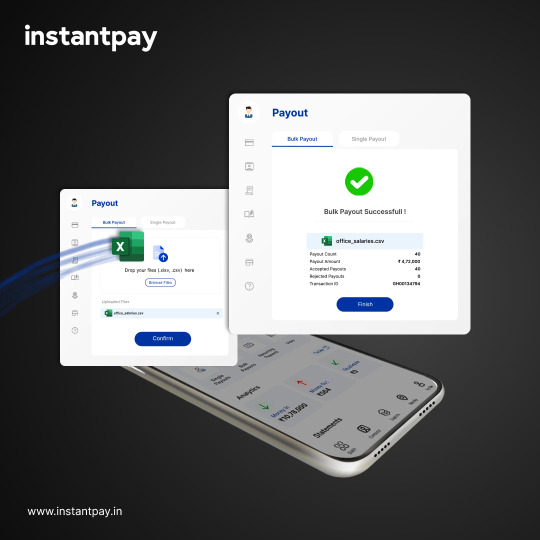
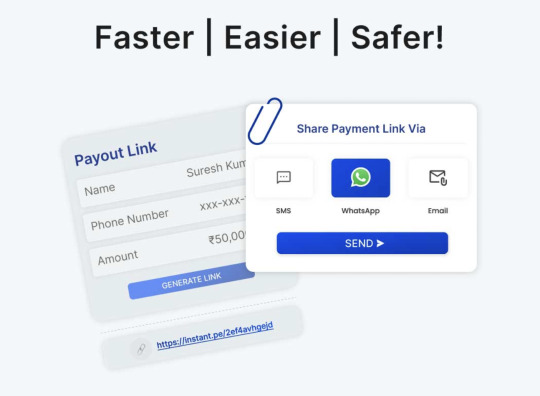
How is Payouts different from using banks for bulk payouts?
While banks have been the cornerstone of financial transactions for centuries, there are certain limitations when it comes to bulk payouts:
Time: Traditional bank transfers can take several days, especially for large volumes. With Instantpay's Bulk Payouts, transactions are almost instantaneous, ensuring businesses can operate without monetary delays.
Flexibility: Banks often have fixed operating hours. With Instantpay, you have the flexibility to send and receive payouts 24/7/365, catering to businesses that operate outside conventional hours.
Ease of Use: Setting up bulk payouts with banks can be a cumbersome process with a lot of paperwork. Instantpay provides a streamlined online interface, making the setup process a breeze.
Real-time Tracking: Instantpay offers real-time tracking of transactions, something that many traditional banks lack, giving businesses better control and visibility over their funds.
Send money to multiple recipients with Payouts
Handling payouts for a large number of recipients can be a logistical nightmare. Be it vendor payments, affiliate commissions, or salary disbursements; businesses often grapple with the challenge of ensuring timely and accurate payouts.
With Instantpay's system, sending money to multiple recipients is simplified:
User-friendly Dashboard: Easily add beneficiary details and track the status of each payout.
Multiple Transfer Modes: Whether it's bank transfers, UPI, or wallets, businesses can choose how they want to send money, ensuring recipients receive funds in their preferred manner.
Automated Payouts: Set up automated rules and schedules, so you don’t have to initiate payouts manually every time.
How can I get started? What documents are needed for Instantpay Payouts?
Diving into the realm of modern payout systems with Instantpay is straightforward. To get started, you would typically require:
Identity Verification: This usually involves standard KYC (Know Your Customer) documents such as PAN card, Aadhaar card, or other government-approved IDs.
Bank Account Details: Ensure you have the details of the bank account where you want the funds to be transferred.
Business Registration Proof: This could be your incorporation certificate or any relevant legal documentation that authenticates your business's existence.
Instantpay's platform provides a user-friendly interface, guiding you through every step of the submission process.
Does Instantpay support payouts to all banks and bank accounts?
Yes, with Instantpay, flexibility is at the core of their offering. Businesses can transact with almost all major banks and numerous types of bank accounts, be it savings, or current accounts. This universality ensures that no matter your bank or account type, Instantpay's bulk payouts have you covered.
Can you transfer funds on Sundays and bank holidays?
In today's fast-paced business environment, financial operations don't stick to the traditional 9-5. Recognizing this, Instantpay enables businesses to transfer funds 24*7*365. So whether it's a Sunday, a bank holiday, or late at night, you can rest assured that your transactions will go through without a hitch.
Does the payout transfer happen instantly?
In most scenarios, yes. Instantpay is designed to facilitate swift transfers. Payouts for IMPS, NEFT, UPI, and Wallets are processed instantly. However, in the case of RTGS, which is mostly used for high-value transactions, it can take 1-2 hours to ensure secure processing.
What if my transaction is pending or under process under payouts?
Kindly allow a brief period for the transfer's conclusive status to be determined. Upon completion of the processing, either the bank or NPCI will notify you about the payout status through an email. This notification will confirm whether the transaction was successful or if a refund has been initiated.
Is it simpler to send bulk payouts via file uploads or APIs?
Both file uploads and APIs have their unique advantages when it comes to sending bulk payouts. File uploads, for instance, are straightforward for businesses that already have payment details documented in spreadsheets. Just a simple upload and the process is initiated.
On the other hand, using APIs offers more flexibility and automation. With APIs, businesses can integrate their systems directly with the payout service for seamless transfers. For businesses aiming for scalability and automation, API-based bulk payouts might be the way forward.
How does Instantpay bulk payouts work?
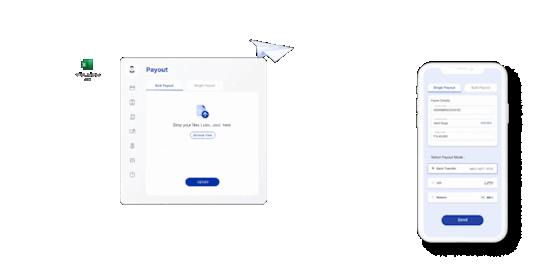
The efficacy of Instantpay Bulk Payouts lies in its simplicity and efficiency. Businesses can choose between the file upload method or the API integration, depending on their preference. After choosing the method:
Prepare your bulk payout details in a specified file format.
Upload or send this data to Instantpay.
The Instantpay system processes these transactions securely and swiftly, ensuring that each recipient gets their due amount without hitches.
What is the maximum number of payouts that can be processed using Instantpay Bulk Payouts?
One of the distinguishing features of Instantpay Bulk Payouts is its capability to handle a large volume of transactions. Depending on your business subscription and package, the platform can process thousands of transactions in a single batch. This means, even if you're a large enterprise with numerous payouts, Instantpay ensures timely and accurate disbursements. Using the Bulk Payouts feature, you can process up to 10,000 payouts at once.
How can I check the transaction status for Instantpay Bulk Payouts?
Once you've finalized your Bulk Payouts, navigate to the Bulk Payout page for a comprehensive summary of your latest transactions. This overview displays the quantity of files uploaded, the cumulative number of payouts, those that have been processed, and the overarching transaction status. This page serves as a handy dashboard to seamlessly monitor the trajectory and current standing of your bulk payouts.
What is Instantpay’s Scheduled Payouts for Payments?
At the heart of Instantpay’s innovative offerings is their Scheduled Payouts system. Think of it as a set-it-and-forget-it system where businesses can program their transactions in advance. Whether it's disbursing employee salaries, vendor payments, or handling customer refunds, Scheduled Payouts lets businesses automate their recurring payments, ensuring punctuality and eliminating the hassle of manual interventions.
Is it Possible to Schedule Payouts in Advance?
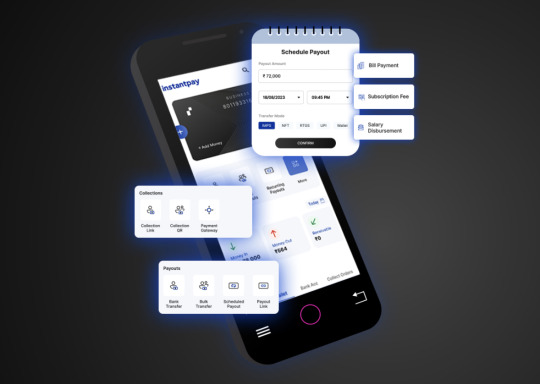
Absolutely! One of the standout features of Instantpay's Bulk Payouts is the capability to pre-set transactions. This foresight ensures businesses are always a step ahead, providing reliability not just for the company itself but for those on the receiving end of these transactions. By simply inputting the necessary details and setting the desired transaction date, businesses can rest easy knowing their financial obligations will be met.
Can I Check the Status of Instantpay’s Scheduled Transactions?
Transparency is crucial when dealing with finances. With Instantpay, you're never in the dark. Once your payouts are scheduled, you can easily track and monitor the status of each transaction. Every scheduled payout comes with a detailed status report, giving businesses the confidence and assurance that their funds are being processed correctly and timely.
Diving into the Payout APIs with Instantpay
An innovative payout platform tailored to modern business needs. But beyond its core features, how does its API stand out?

Let's dive in!
Payouts Overview - API
The Instantpay API serves as the backbone for developers and businesses aiming to integrate seamless payouts into their platforms. Whether you're a burgeoning startup or a well-established conglomerate, understanding this API can revolutionize how you handle transactions.
Why an API for Payouts?
Traditional methods of processing payments can be cumbersome, particularly for businesses that handle a high volume of transactions. Manual interventions, the risk of errors, and time-consuming procedures are just some challenges. An API-driven approach, like that of Instantpay, streamlines these processes, enabling businesses to automate payouts, reduce errors, and improve efficiency.
Key Features of the Instantpay Payout APIs
Automation: With the API, businesses can set up automated workflows for payments. Whether it's paying suppliers at the end of every month or disbursing salaries, the API ensures timely, error-free transactions.
Real-time Tracking: The Instantpay Developer API allows businesses to track the status of their payments in real-time. No more waiting or guessing – get instant updates on your dashboard.
Bulk Payments: Handling mass payouts? No problem. With the API, businesses can manage bulk payments efficiently, ensuring all beneficiaries receive their dues promptly.
Enhanced Security: The API is built with robust security protocols, ensuring that all transactions are encrypted and secure.
Integration and Flexibility: Another advantage of the Instantpay API is its ease of integration. Developers can quickly embed it into their platforms, thanks to well-documented resources and support from the Instantpay team. Moreover, its flexibility means it can be tailored to various industries, be it e-commerce, healthcare, or finance.
Conclusion
In a competitive market, businesses need every edge they can get. Streamlined financial processes are more than just a convenience; they're an essential part of modern business operations. Instantpay's innovative payout solutions, be it their Bulk Payouts, Scheduled Payouts, or the Payout APIs, offer businesses that crucial edge.
Leveraging these tools ensures not just operational efficiency but also fosters trust among clients, employees, and vendors, reinforcing a brand's credibility and reliability.
0 notes
Text
Instantpay APIs as Enablers of Financial Inclusion and Accessibility

In today's digital era, financial inclusion and accessibility have emerged as crucial factors in empowering individuals and businesses. The ability to access and utilise financial services seamlessly has a profound impact on economic growth and social development. This is where application programming interfaces (APIs) play a transformative role. APIs are the building blocks of modern software, allowing different applications to communicate with each other and share information. In the context of financial services, APIs enable seamless integration of various financial products and services, providing customers with a more convenient and inclusive experience. APIs have also led to the emergence of innovative business models, such as open banking and digital lending, which have transformed the financial landscape. In this article, we will explore how APIs are revolutionising the financial landscape and how InstantPay's APIs are paving the way for greater financial inclusion and accessibility. Join us on this journey as we uncover the untapped potential and endless possibilities that APIs bring to the table.
The Role of APIs in Financial Services
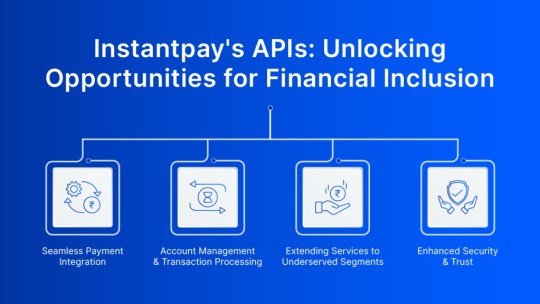
APIs act as the digital bridges that connect various systems, platforms, and applications, enabling seamless communication and data exchange. Their impact on financial services has been nothing short of transformative, revolutionising the way financial institutions, fintech companies, and other stakeholders interact, collaborate, and deliver services to customers. APIs facilitate secure and efficient data sharing, enabling financial institutions to leverage external services and capabilities to enhance their offerings. They enable developers to access and utilise functionalities provided by third-party providers, creating a more connected and integrated financial ecosystem. Let’s explore their benefits and impact on various aspects of the industry.
Enhancing Interoperability and Collaboration: One of the key advantages of APIs in financial services is their ability to enhance interoperability and collaboration between different players in the industry. APIs provide standardised interfaces that allow systems to seamlessly exchange data, enabling financial institutions to integrate with external services and leverage their capabilities. This opens up a world of opportunities for collaboration, enabling the creation of innovative products and services that meet the evolving needs of customers.
For example, a bank can integrate its systems with a payment gateway API to offer customers a wide range of payment options. This collaboration enhances the customer experience, making transactions more seamless and convenient. APIs also enable partnerships between financial institutions and fintech companies, facilitating the development of innovative solutions that combine traditional banking services with cutting-edge technologies such as artificial intelligence, machine learning, and blockchain.
Enabling Open Banking and Data Sharing: APIs play a crucial role in the implementation of open banking, a regulatory framework that promotes the sharing of financial data between banks and third-party providers. Through APIs, banks can securely share customer data with authorised third-party providers, allowing them to access account information, initiate transactions, and provide value-added services. This level of data sharing fosters competition, innovation, and customer empowerment as customers gain more control over their financial data and can benefit from a wider range of services.
For instance, a personal finance management app can access transaction data from multiple banks through APIs, offering customers a comprehensive overview of their finances and providing personalised financial advice. APIs ensure the secure and controlled sharing of data while protecting customer privacy and maintaining regulatory compliance.
Driving Innovation and Customer-Centric Solutions: APIs are catalysts for innovation in the financial services industry. By exposing functionalities and data through APIs, financial institutions can tap into the collective creativity of developers and foster the development of new, customer-centric solutions. APIs enable rapid prototyping, allowing developers to build and test applications quickly, resulting in a faster time-to-market for innovative products and services.
For example, APIs have enabled the rise of peer-to-peer (P2P) payment platforms that allow users to send and receive money instantly. These platforms leverage APIs provided by financial institutions to initiate transactions securely and seamlessly. APIs also enable the integration of financial services into other platforms and applications, such as e-commerce websites or mobile apps, providing customers with a seamless and integrated experience.
Improving Operational Efficiency and Cost Savings: APIs streamline processes and improve operational efficiency in financial institutions. By exposing functionalities through APIs, institutions can automate tasks, reduce manual intervention, and eliminate redundancies. This leads to improved efficiency, reduced errors, and cost savings.
For instance, APIs can facilitate real-time integration between a bank's core banking system and its customer relationship management (CRM) system, ensuring that customer data is always up-to-date across both systems. This eliminates the need for manual data entry, reduces the risk of errors, and enhances the overall customer experience.
Instantpay's APIs: Unlocking Opportunities for Financial Inclusion
Instantpay's API suite empowers businesses, fintech companies, and others to build innovative financial solutions that bridge the gap and unlock opportunities for financial inclusion.Seamless Payment Integration: One of the key aspects of Instantpay's APIs is its seamless payment integration capabilities. The payment APIs allow businesses to integrate various payment methods, including UPI, net banking, wallets, and more, into their platforms or applications. This integration enables businesses to offer convenient and diverse payment options to their customers, catering to their specific needs and preferences. By providing a wide range of payment choices, Instantpay APIs promote financial inclusion by ensuring that individuals from all walks of life can access and participate in digital transactions. Account Management and Transaction Processing: With the Instantpay APIs, businesses can manage user accounts, including user verification, KYC compliance, and transaction history. This level of account management ensures a secure and trusted environment for financial transactions. Additionally, the API enables businesses to process transactions seamlessly, ensuring swift and efficient payment processing and thereby enhancing the overall user experience. These features not only enable businesses to offer accessible financial services but also provide individuals with the necessary tools to manage their finances effectively. Extending Services to Underserved Segments: One of the significant advantages of InstantPay's APIs is their potential to extend financial services to underserved segments of the population. The API allows businesses to reach individuals in remote areas or regions with limited access to traditional financial institutions. By leveraging the API, businesses can provide these underserved individuals with access to digital financial services, enabling them to participate in the formal economy, make secure transactions, and build a financial identity. As a result, Instantpay's APIs play a crucial role in empowering the unbanked and underserved populations, fostering financial inclusion, and reducing the financial gap. Enhanced Security and Trust: Security is a critical aspect of financial transactions, particularly in the digital realm. Instantpay APIs prioritise the security and privacy of user data and transactions. The API implements robust security measures, including encryption protocols, secure authentication, and compliance with regulatory standards. By providing a secure environment for financial transactions, the APIs build trust among businesses, customers, and other stakeholders. This trust is crucial to encouraging individuals to adopt digital financial services and participate fully in the digital economy.
In Conclusion
The financial industry is experiencing rapid evolution, driven by the transformative power of APIs. These innovative technologies are revolutionising the sector, opening doors to financial inclusion and accessibility. Instantpay's APIs are a game-changer, providing businesses with a unique opportunity to harness this revolution and unlock their full potential by seamlessly accessing essential financial services. To embark on this exciting journey of growth and possibilities, visit https://app.instantpay.in/developer-api today and learn more about how Instantpay can empower your business. Don't miss out on the chance to be at the forefront of this financial transformation.
0 notes
Text
Banking APIs for all your needs
In this world full of digital technologies, you can do almost all things online from ordering groceries to paying your bills and booking flight tickets. Today’s consumers want convenience and businesses need to accommodate their needs.
With the ever-growing digital economy, innovative banking and payment solutions are helping businesses transform their processes and optimize their go-to-market strategies. And that’s where APIs are playing an important role in enabling fast, secure & efficient financial services in our lives.
How are APIs playing an important role in digital transformation?
Simply put, APIs (Application Programming Interface) allow interactions between multiple applications, devices, and data, making all the digital transactions possible on the web.
These modules are helping businesses eliminate their process flaws and achieve organizational goals more effectively.
With InstantPay’s modular banking APIs, it has now become easier to develop a new application or product that has all the necessary functionality for new-age businesses.
Encouraging digital transformation, businesses can greatly benefit from these tools by building products and use cases around these APIs.
Here’s how APIs are indispensable to companies; enabling better, digital business processes:Integration is now easier and more effective
APIs make it easy and effective to integrate banking into any application. These pre-built tools offer the most efficient way to achieve multi-platform connectivity according to business’ specific requirements.
The APIs not only simplify the integration but allow you to get better results while reducing the development time and costs.
Likewise, InstantPay’s API banking platform allows developers to select desired modules, validate code in a sandbox environment, and launch their product faster.
You just need to plug-n-play our modular APIs that give you freedom from any complex integrations.
Innovate and scale your business
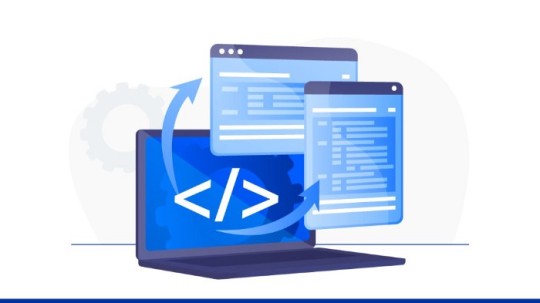
Whether it’s Payments, Collections, Expense and Card Management, Investments, or Lending, our powerful APIs will ensure that you streamline and modernize your business processes swiftly.
Give a better experience to your customers
In addition to providing access to transaction processing along with its control and management, APIs serve the basis for user experience and are responsible for the simplicity and usefulness of an app or website. They help you design products around customer experience and bring coveted results.
Using modular payment APIs, you can ensure a smooth flow of money and manage all your financial transactions in real-time. They help create a smooth experience for the users while adding value to your business.
In Conclusion
The above discussion explores how API solutions can support digital transactions and empower businesses to accept and process payments conveniently.
Moreover, these sophisticated tools have capabilities required to bridge the gap between business and banking, ensuring connectivity and collaboration for small and medium businesses.
InstantPay, a modern API banking platform for businesses, helps you embed banking, payments, and other functionalities you need into your product or services.
It provides proven APIs and you don’t need to invest extra time and money in painful integrations. Be it vendor payments, collection from customers, or business expense cards, we have powerful API solutions for all your banking needs.
0 notes
Text
How Businesses Can Simplify Payment Process Using Payouts?
Managing payments is quite a challenging but important process for any business. Over the years, businesses have implemented new ways to improve their payment processes.
With the increasing demands of enterprises to run their operations smoothly and reliably, the need for better digital payment systems is increasing.
If you are also a growing business and want to improve the payment process for your employees, partners, suppliers, and customers, then a well-designed payout solution will work well for you.
As a major neo-banking platform for small to large businesses, InstantPay helps you to stay ahead in the complex business landscape with its smart payments solutions designed for the new India.
Let’s understand Payouts and how InstanPay facilitates businesses to innovate and grow through its on-demand business payout solutions.
What are Payouts?
Payout simplifies the process of making payments to vendors, employees, channel partners, etc. By using an effective payout solution, a business can pay its recipients in real-time. It allows you to transfer money directly to beneficiaries’ bank accounts, cards, or wallets. Plus, it makes it easier to pay in bulk.
Types of Payouts for Businesses
There are several types of payouts for a business, including but not limited to:
Employee Payouts: Salaries, reimbursements, and incentives are common employee payouts.
Vendor Payouts: Payments made by businesses to their suppliers and vendors to provide goods and services are vendor payouts.
Partner Payouts: Payments such as commissions to retailers, distributors, and allied business entities are partner payouts.
Customer Payouts: Payments to customers regarding cashback, rewards, refunds, etc. are customer payouts.
How Important are Payouts for Your Business?

Scale Your Business with InstantPay Payouts
Making timely payouts is as important as receiving payments. We can say that an effective and reliable payout solution plays an important role in the success of any business by simplifying its payments process.
Also, it is helpful to improve your money movement and expense management while building trust with your partners and customers.
Keeping today’s evolving business challenges in mind, we’ve designed and built effective payout solutions that automate all types of payments and make sending money a seamless experience.
And the core aim here is to simplify your complex business banking transactions and add value to your business.
Single or bulk, InstantPay payouts empower you to send money in a matter of minutes. Also, you don’t need to worry about bank holidays or restricted working hours as you can payout 24*/7 via IMPS, NEFT, RTGS & UPI using our mobile/desktop application.
Do More Than Just Payments
With InstantPay you can carry out frictionless payouts to the bank, wallets, cards and enables you to schedule & track your queued, affected payments anytime.
Besides, our scalable payout solution can process over a million payouts in a day, so you don’t have to make the extra manual effort.
With useful features like validating beneficiary bank accounts before initiating payment, scheduling, and tracking of funds, etc., the
InstantPay payout solution is great for expanding your business payment options. It not only automates transactions but helps you to capture the dynamic market environment with reliable and quick payouts.
Moreover, our in-demand payment tools have been designed to effectively streamline your business banking operations without any complex integration.
Making business transactions easy and quick, the InstantPay platform lets you keep track of all your outward payments while reducing manual efforts and saving time.
So, get started with InstantPay payouts today and make secure and timely payments to all your payees with the control and flexibility your business needs.
0 notes
Text
Why choosing the right business banking platform is crucial for businesses?
If you are a new entrepreneur or an established organization and want to manage all your business finances efficiently, choosing the right banking platform is one of the most important things to do.
Built specifically to suit the specific needs of businesses of all sizes, InstantPay’s business banking platform offers a smart digital current account that is designed to meet the emerging needs of today’s entrepreneurs.
The online banking platform also provides you with innovative features that empower you to automate your business transactions and improve your money management.
With InstantPay, you can digitize your entire payment process within minutes while simplifying business banking.
Link/open digital bank account to simplify day-to-day transactions

Our digital banking platform allows you to send and receive money online for efficient and smooth payments. With the account, you can better manage your large volume of transactions and keep the business operations smooth-running.
Also, it empowers you to streamline your business banking with multiple payment methods, smart reporting, and other value-added services.
Track, manage payments and expenses in real-time
The InstantPay account comes with a powerful dashboard that offers real-time reporting and insights for your day-to-day business transactions.
Giving a complete overview of all your payments and expenses at a glance, the platform makes it easy for you to make informed decisions for your growing business.
Pay your vendors and partners directly from the account
Leveraging the InstantPay platform, you can automate your business payments process without any complex banking integration. You can pay your vendors, suppliers, and other business partners 24/7 via multiple modes. Be it a single payment or bulk, you can payout to banks, wallets, and cards with one click.
InstantPay delivers you more than just banking
In addition to making your business banking operations smoother and more efficient, the InstantPay platform offers you value-added benefits like instant validation of beneficiary accounts before payments to avoid any fraud or risk.
Here you can do more than what you can do with a traditional current account and enjoy a seamless banking experience from the comfort of your home or office.
InstantPay’s digital current account with other useful features provides your new or evolving business with end-to-end money movement and management capabilities.
So, open your new-age digital current account or connect the existing one on the InstantPay platform and access as well as manage funds on the go.
0 notes
Text
How InstantPay boosts your accounts receivable process
For an organization to meet its cash flow goals, it needs to have an effective account receivables process. This ideal process is which ensures that companies get their payments quickly, process invoices faster, and improve their collection timelines, which in turn will contribute to increased cash flow.
Receiving on-time payments from customers is fundamental to the success of any business. With InstantPay, you can develop an efficient and seamless accounts receivables process to help reduce collection costs, save time, and maximize resources.
Here in this blog, we discuss some of the key collection strategies and best practices that will help you in accepting and receiving customer payments quickly and effortlessly.
Accept payments seamlessly from your customers 24×7
With an InstantPay business account, you can quickly collect payments from your customers anytime, anywhere. Here you get instantly paid via UPI, net banking, cards, and other options.
Whether you run a small business, retail shop, or e-commerce website, we have integrated payment collection solutions to your unique needs.
Now you can accept all your payments 24×7 using our neo banking services crafted for businesses, small or large. Also, you can easily integrate our APIs to meet your specific business banking needs.
Today, our smart, flexible, and secure digital payment solutions are used by thousands of businesses including retail, corporate, education, logistics, e-commerce, and so on.
Collect payments hassle-free via Email, WhatsApp, and SMS links
Payment links are an easy and secure way to receive payments for goods and services. Using InstantPay’s payment collection solution, you can share payment links with your customers via Email, WhatsApp, or SMS to collect money swiftly via cards, UPI, net banking, and other options.
Also, you can attach invoices and automate your payment collection with ease. Giving a better experience to your customers, these links are ideal for most businesses and are a perfect way to replace cash on delivery.
Get paid on time by sending payment reminders

Automated collections via real-time notifications and MIS
The best way to get paid is through automated collections. We have put an end to confrontational and ineffective collections by putting your customers first and letting your DSO and effectiveness metrics do the talking.
With real-time notifications and MIS, you can save both time and cost on repetitive tasks. Also, it is helpful to stay productive and profitable with automated payment reminders and collections.
A single platform to track and manage your customer payments
Save your time and money by tracking and managing all your account receivables in one place. With InstantPay, businesses can do more than just receiving payments such as tracking customer payments, detailed reporting for better business insights, and other important tasks.
We offer a comprehensive banking platform for small to large businesses where they can collect, track and manage payments easily and efficiently. InstantPay bank account has intelligent tools that make banking and accounting smart.
Our banking platform not only helps you in improved sales but enables you to focus more on your business with its powerful dashboard.
In Conclusion
With a smart and efficient payment collection process, businesses can not only streamline their cash flow but can focus more on their core business process.
At InstantPay, we offer custom and reliable digital payment collection solutions that optimize your accounts receivable process as well as keep your costs low.
With around 1M daily transactions and 10M active customers monthly, we are a trusted partner for many small and large businesses today.
0 notes
Text
How To Instantly Improve Your Business Payout Process
Nowadays, every business wants to improve its various processes where automating payments is a priority. Not only inward but also outward payments are equally important for the expansion of any small and medium business.
An efficient payout process is essential for quick disbursals, which helps in improving business relationships with vendors, suppliers, and customers.
So, in this blog, we discuss some of the key solutions to stay on top of your accounts payable.
Business Payouts in a Nutshell
Payouts refer to the anticipated financial returns or disbursements from a company’s retained earnings, investments, or annuities. In modern business banking, payouts are much more than just processing payments covering financial insights, instant beneficiary authentication, bulk payments, and much more.
Why Do Businesses Want Improvement & Automation?
Managing payouts is a demanding task, and the manual activities of a typical accountant take more than 80% of the time, which affects the overall performance of any business.
Common payment challenges faced by businesses:
No visibility over spending - Business owners must have a simple & clear view of how and where the employee spends.
Multi-channel payments - They want to make it easy to pay in any convenient way.
Lack of integration - Businesses find it difficult to integrate an effective payment system suitable for their company.
Creating a user-friendly experience - It is essential to ensure online businesses' secure and user-friendly payment experience.
Managing receipts manually, etc. - Collecting and managing bills and receipts takes unnecessary time and effort.
Security - Businesses today need advanced and integrated security features.
How You Can Overcome These Challenges & Speed Up Your Business Payout Process
-Manage all your payments in one place with Instantpay
Your business will benefit immensely by managing all your payments from one place. With modern business banking, you can even access multiple bank accounts at the same place and use any of them to make payments to your payees on time, every time. Whether you want to make instant vendor payments or pay in bulk, Instantpay’s payout solutions make it easy.
Disbursing funds securely, quickly, and easily
Smart payments insights and reports on the dashboard
Track all your payments in real-time
Match and reconcile payments on-the-go
Add and validate the beneficiary instantly for future transactions
Schedule post-dated payouts and plan your company finances better
-Modern APIs to Automate All Your Payouts
We at Instantpay make sure that we cater to innovative businesses and make their payout process automated and simplified through our modern payout APIs. Businesses can easily test and integrate these APIs to perfectly automate their internal payout process.
Be it vendor payments, customer refunds, or salary disbursals, our simple and powerful Payout APIs cover it well.
Quickly go live with smart and simple payout APIs and start making instant payouts.
Never miss a payment with easy, real-time reconciliation
Schedule payouts for important payment disbursals
Make bulk payouts with a single click, saving you additional time and effort
Test APIs in a sandbox environment to bring the best for your business
Best-in-class customer support and integration to solve issues immediately
Instantpay Payout Solutions: For All Sorts of Payouts
Since timely payments are vital to the success of every business, automated payouts can bring great benefits to your company.
Payouts from Instantpay is a technology-driven solution to streamline all your outward business payments. It fully automates the payment process so you can make all types of payments quickly and accurately. Plus, you can track, analyse and control payments on a real-time basis from a single unified dashboard.

0 notes